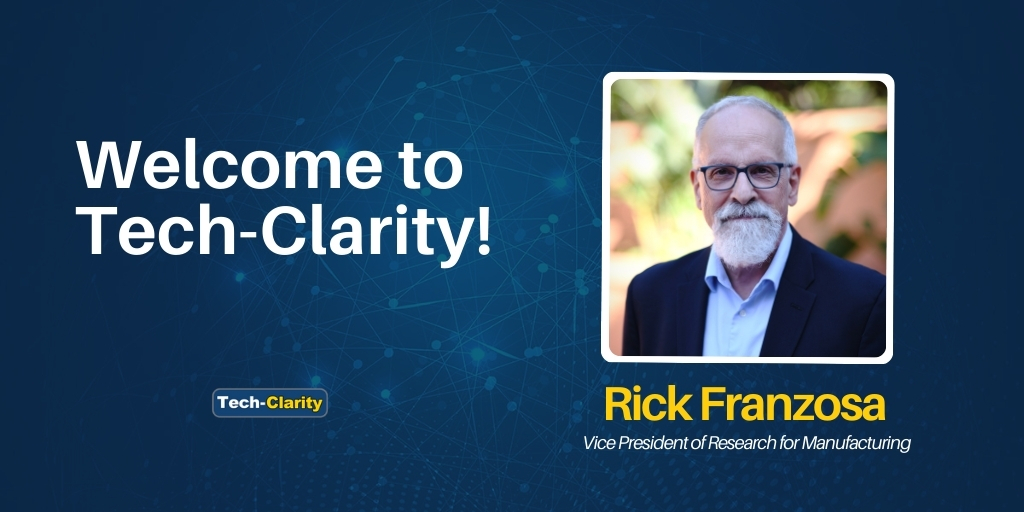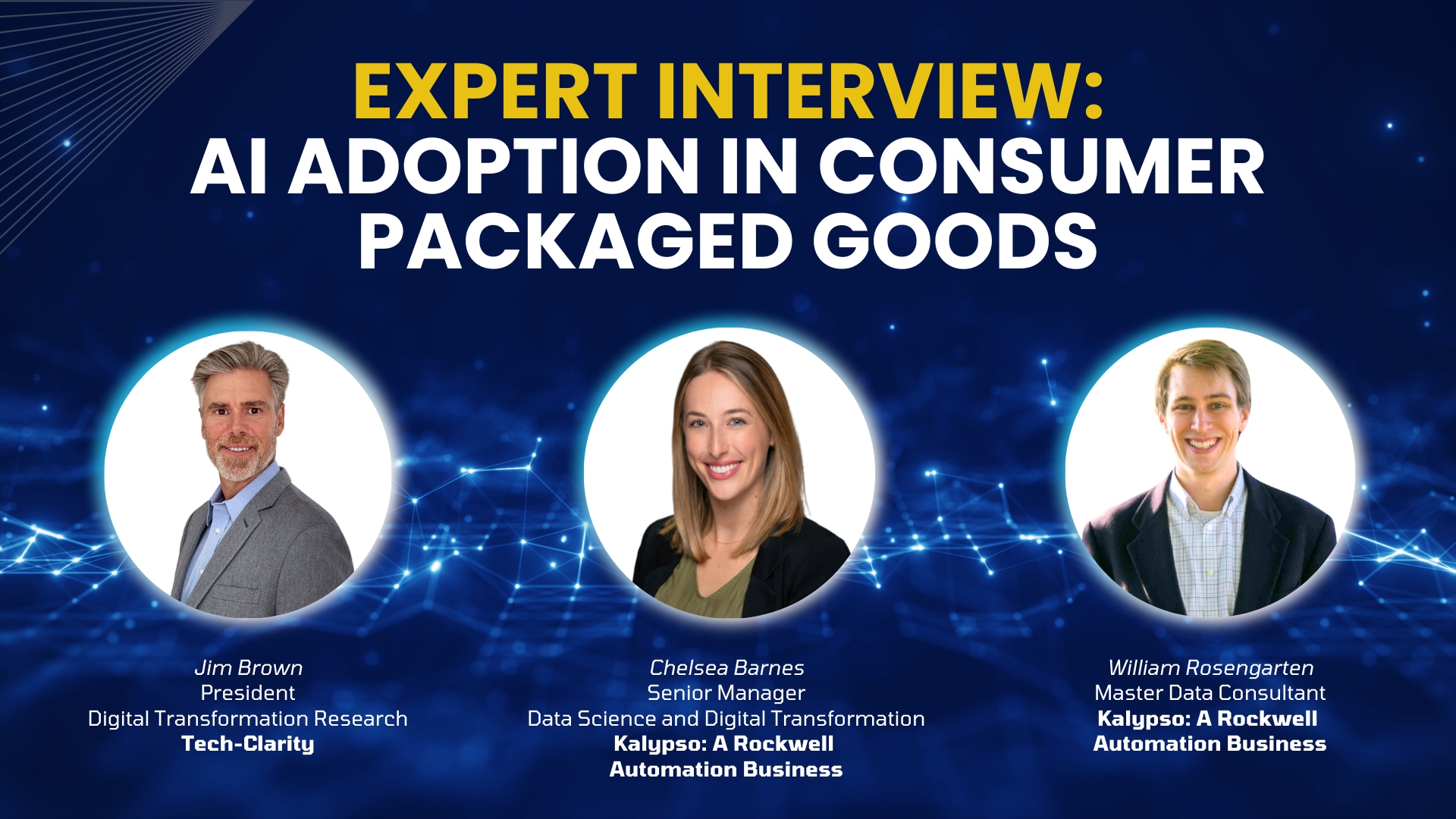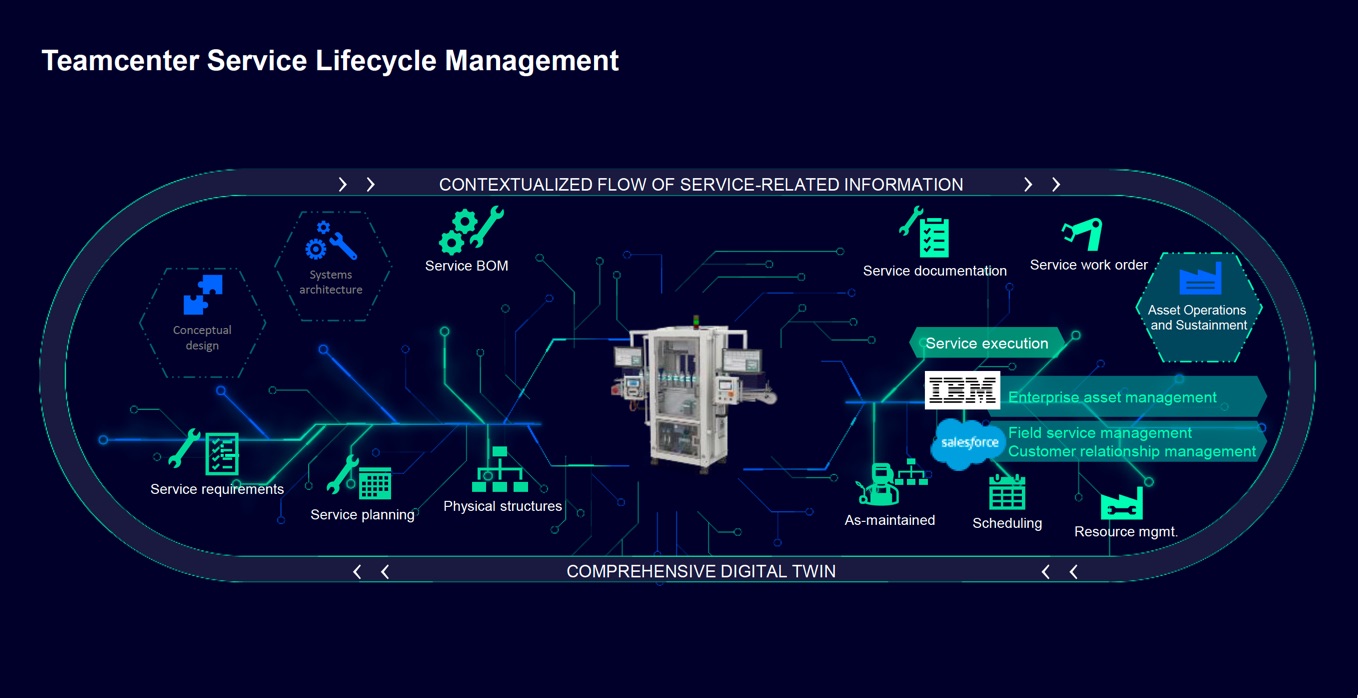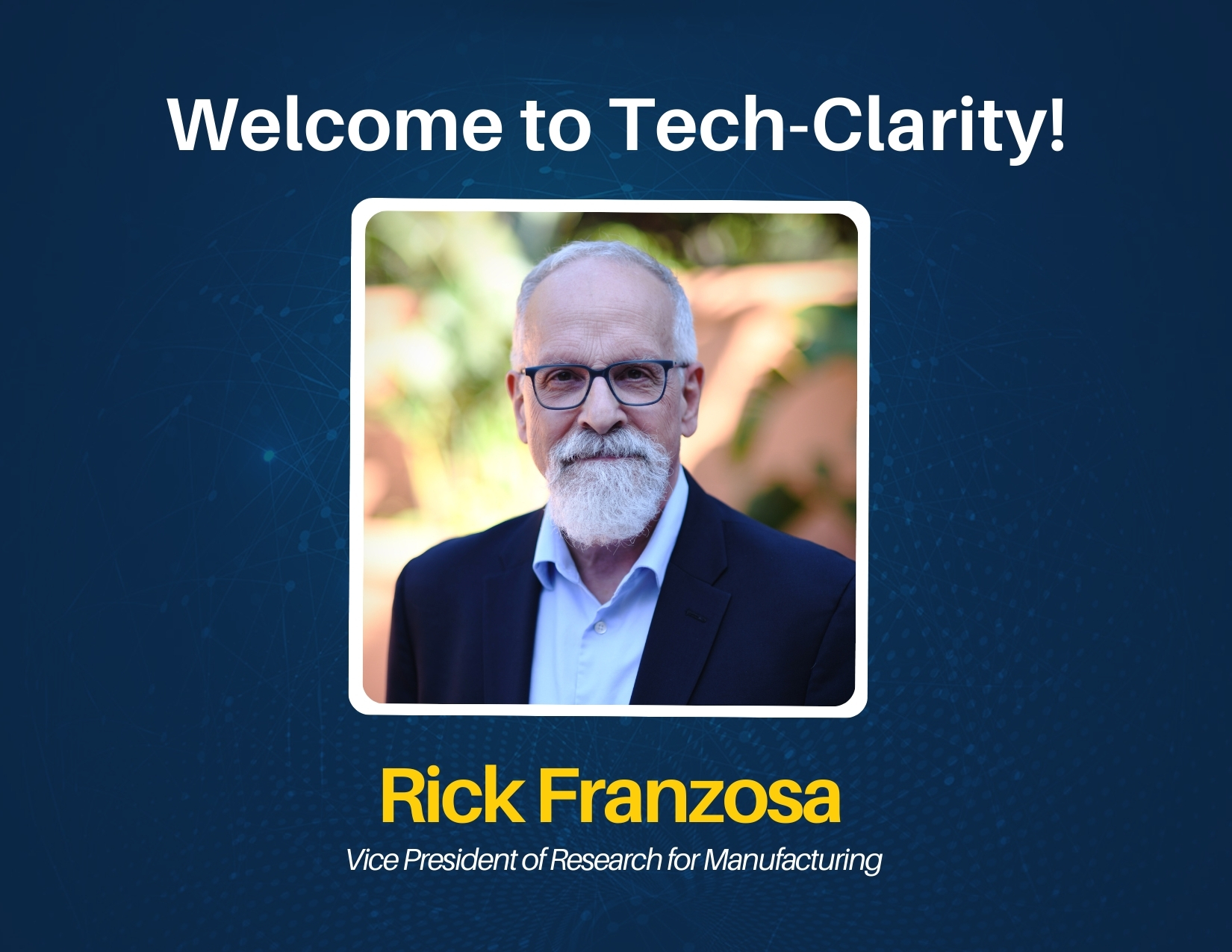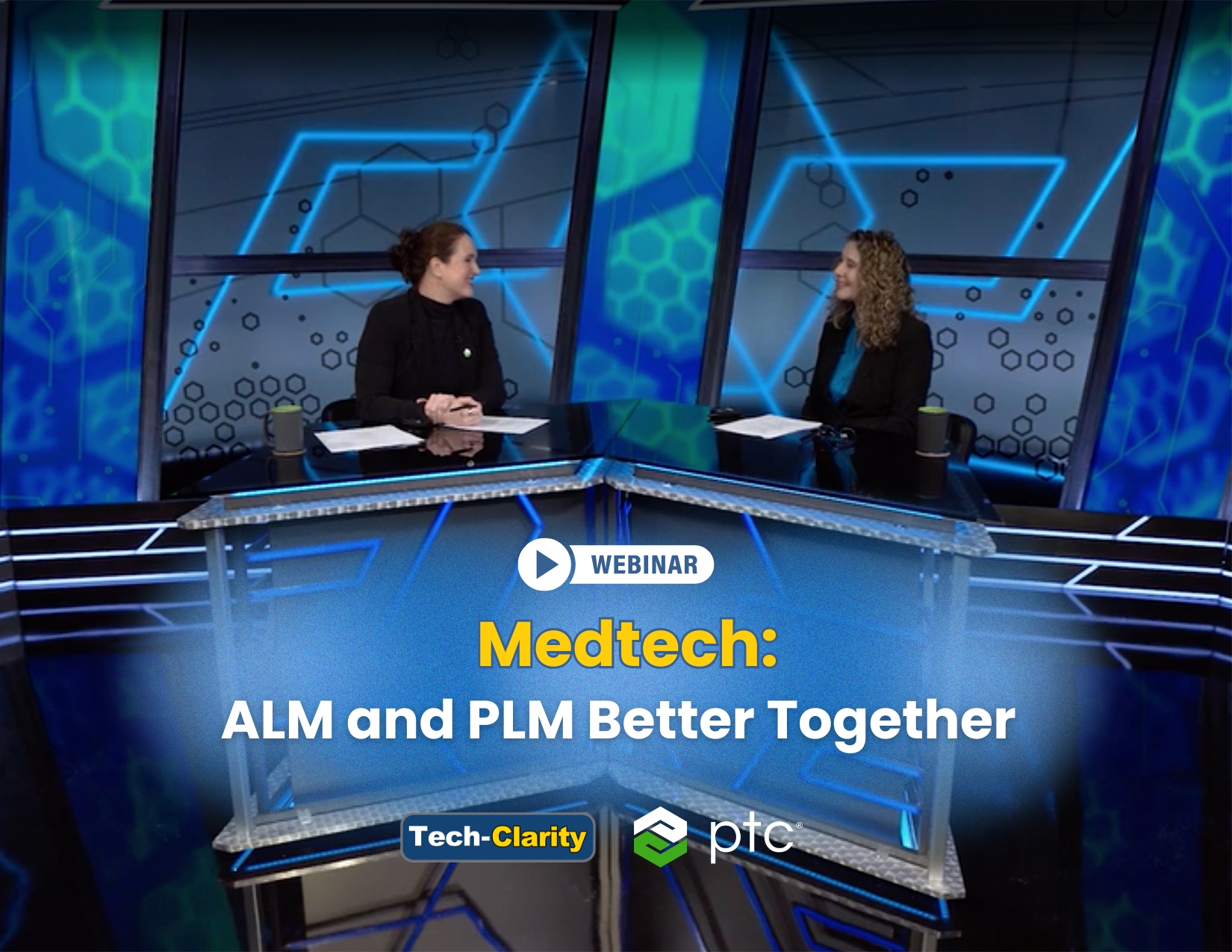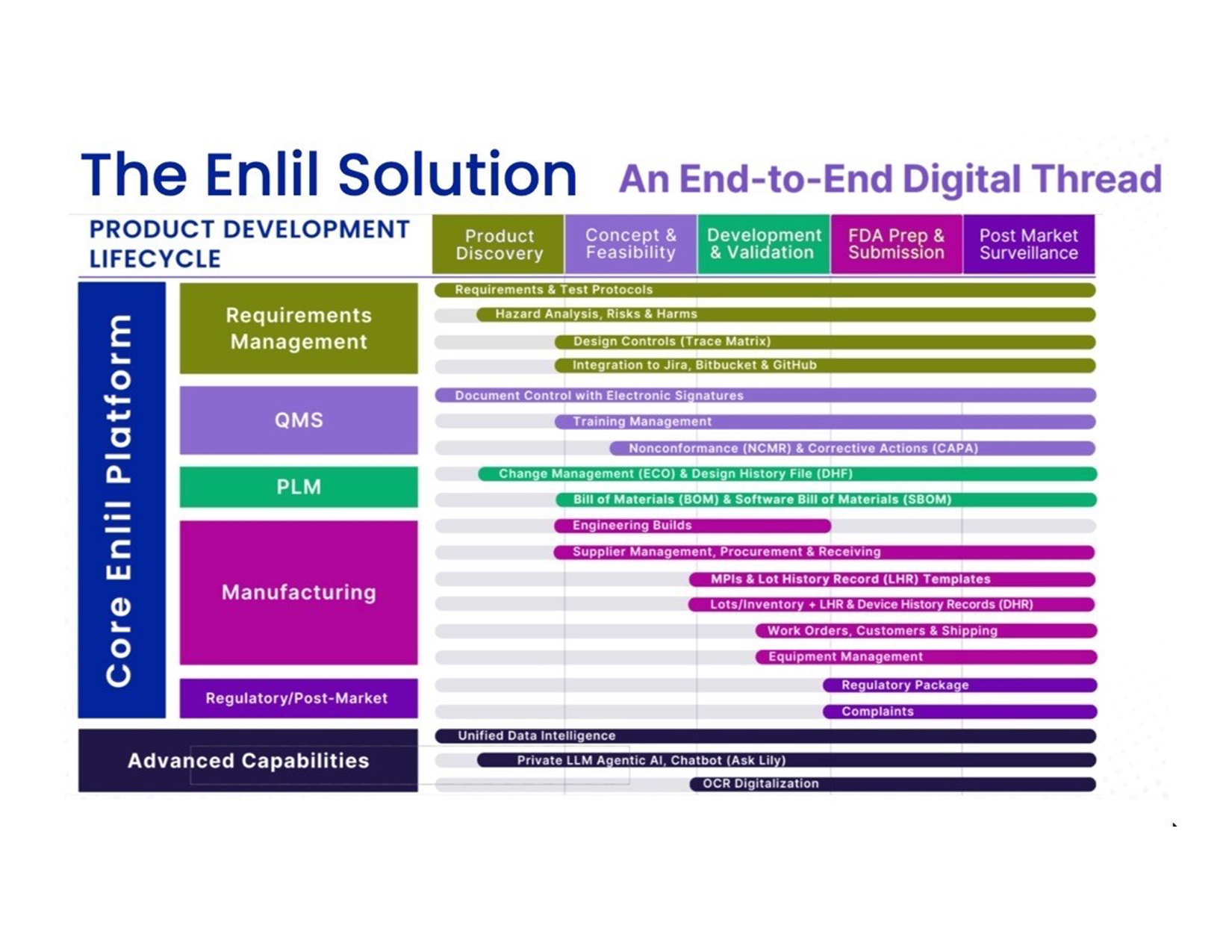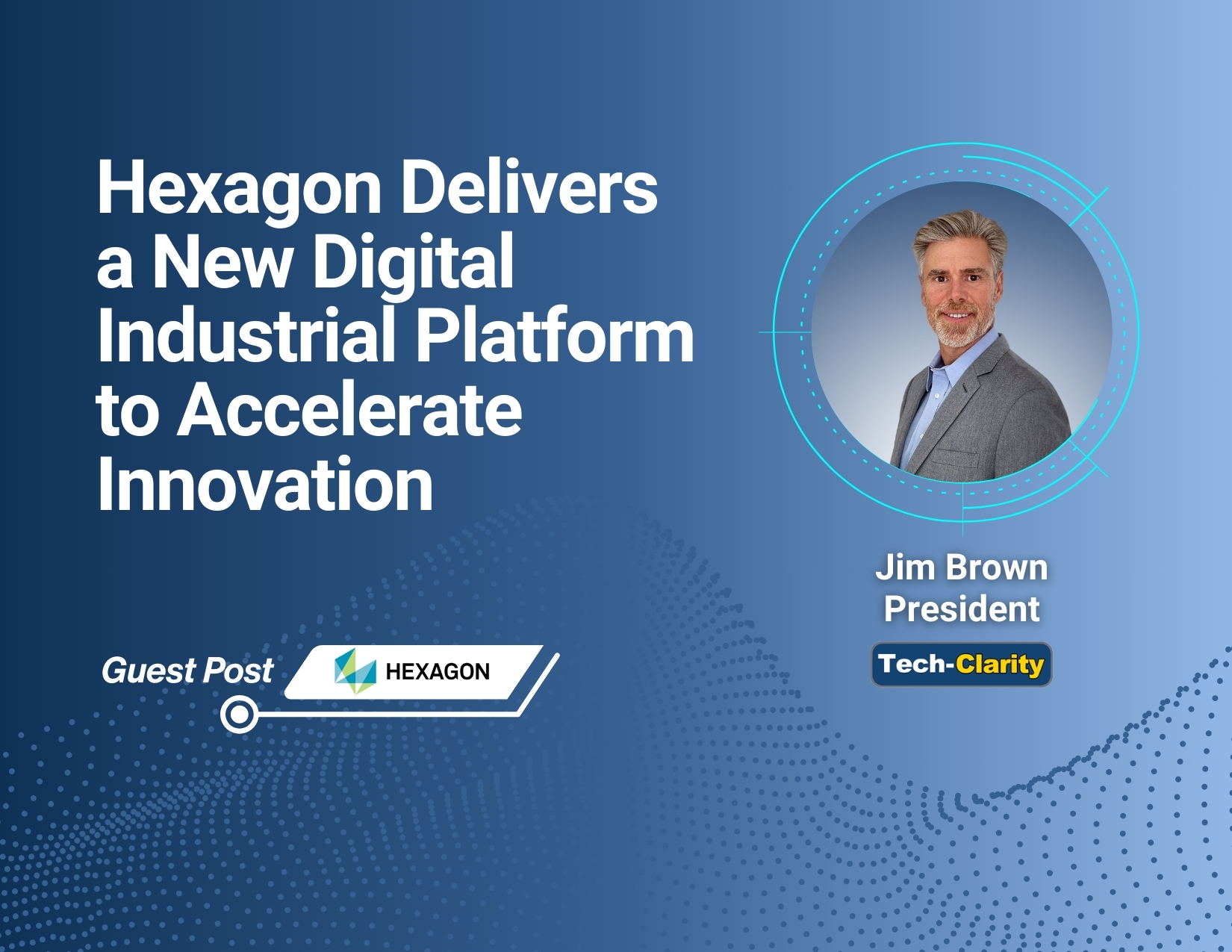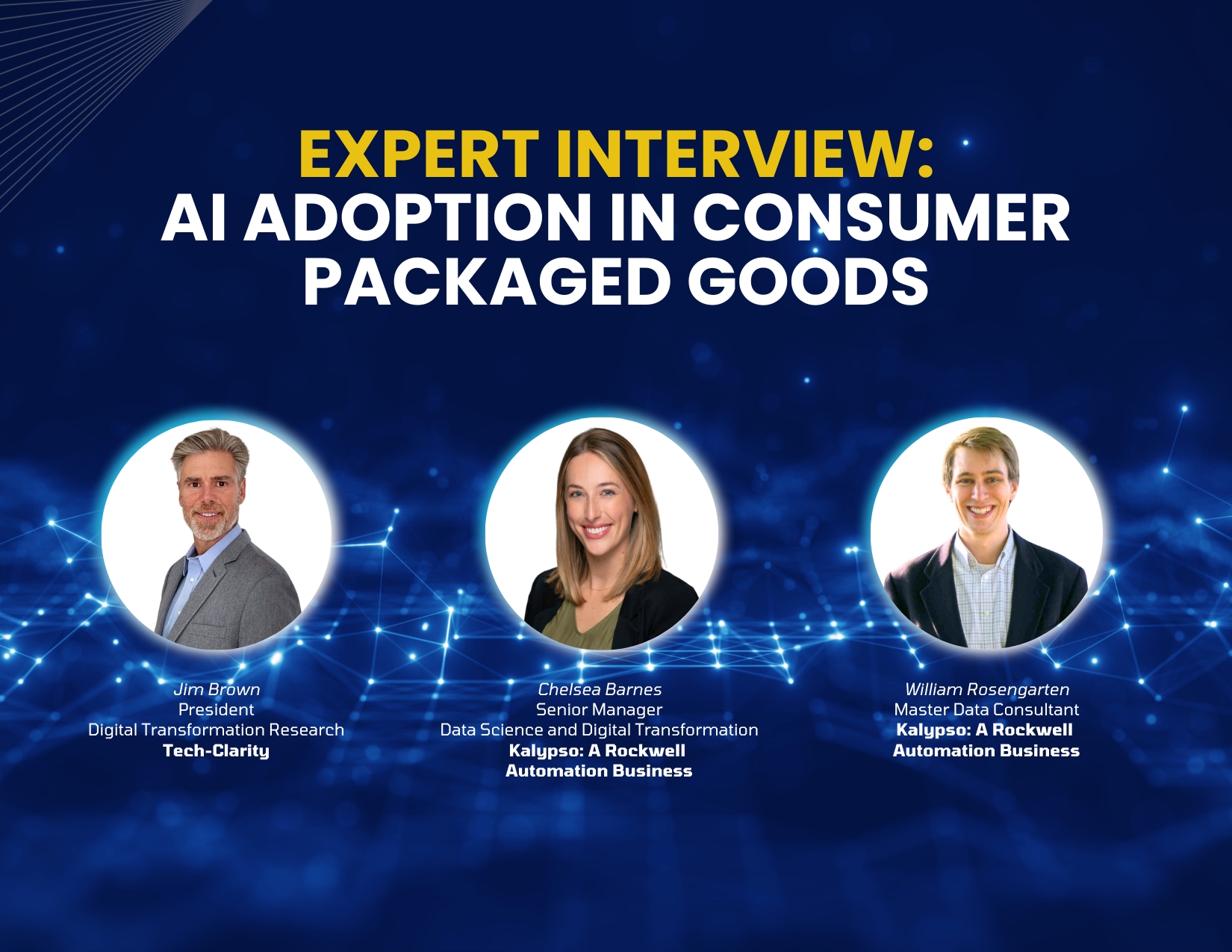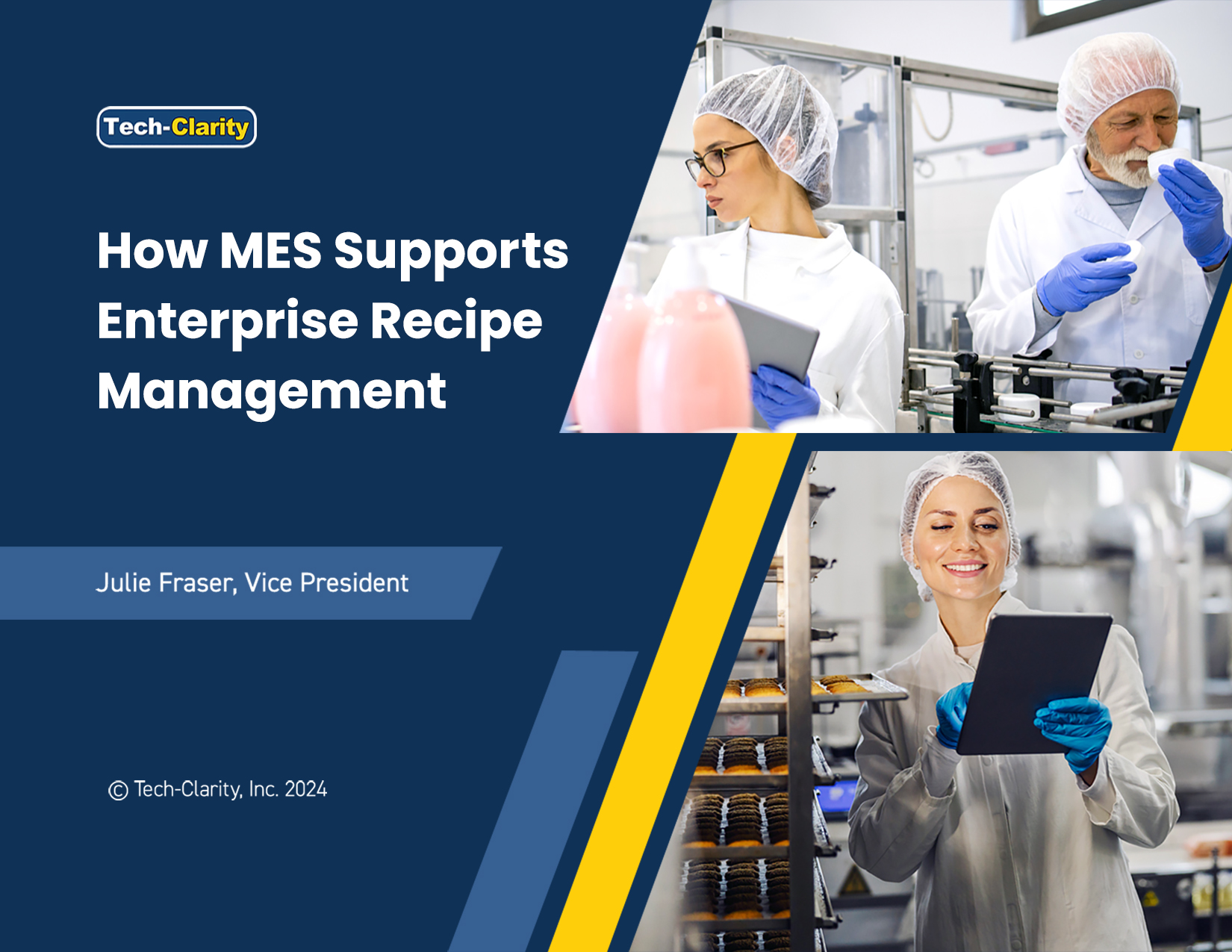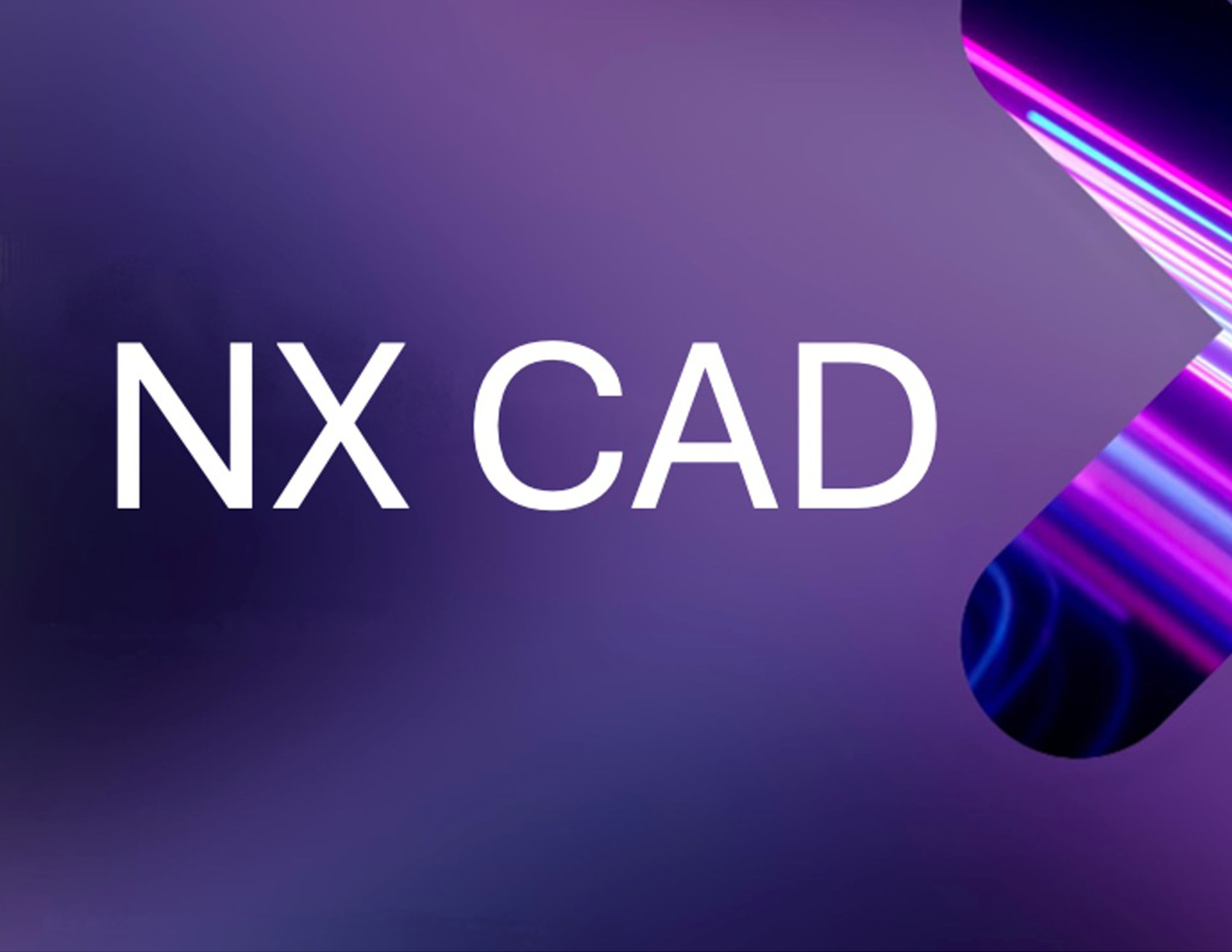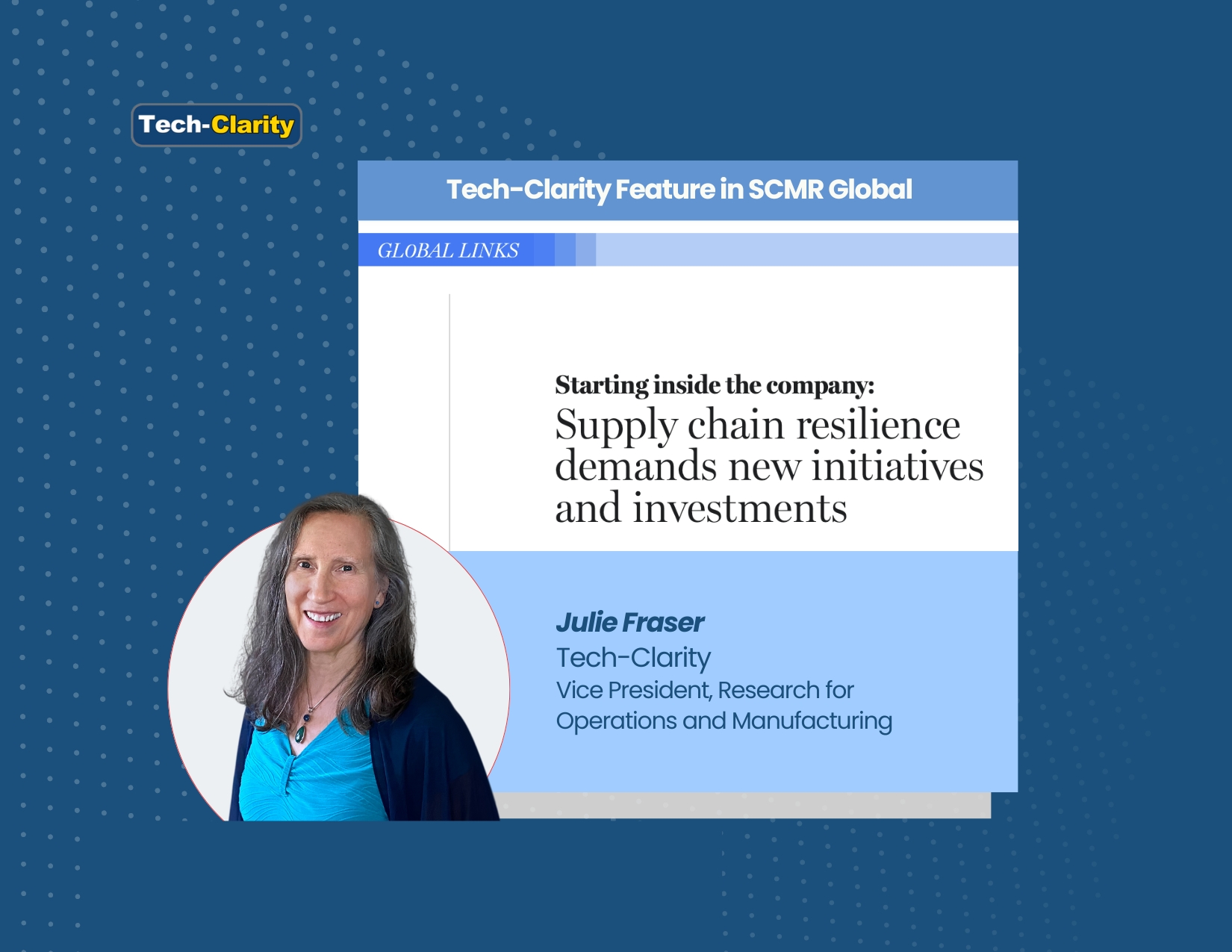ComplianceQuest made some significant announcements at its recent ConQuest customer conference. The first was to identify the space where they play, as a platform and integrated software suite to clean up the messy “middle office.” They also continued to add more agentic AI to the platform to support the people using the applications sitting on…
- Enabling onboarding with collaboration between quality and procurement
- First article inspection to qualify a supplier, pulling the specs and BOM from PLM.
This expansion leverages the collaborative platform and other solutions and adds capabilities to foster greater success with suppliers during a time of supply chain change.
Looking Forward
ComplianceQuest has always leveraged the Salesforce platform for connectivity. As the company builds out its middle office platform and suite, we will continue to watch for new releases, additions, and improvements. Thank you, Nikki Willett, for catching us up on the latest news from ComplianceQuest.
[post_title] => ComplianceQuest Claims Middle Office and Adds Agents [post_excerpt] => [post_status] => publish [comment_status] => open [ping_status] => open [post_password] => [post_name] => compliancequest-middle-office [to_ping] => [pinged] => [post_modified] => 2025-06-05 10:14:29 [post_modified_gmt] => 2025-06-05 14:14:29 [post_content_filtered] => [post_parent] => 0 [guid] => https://tech-clarity.com/?p=22080 [menu_order] => 0 [post_type] => post [post_mime_type] => [comment_count] => 0 [filter] => raw ) [1] => WP_Post Object ( [ID] => 21935 [post_author] => 2574 [post_date] => 2025-05-29 07:00:58 [post_date_gmt] => 2025-05-29 11:00:58 [post_content] => Is AI just a shiny object, or is AI delivering value in manufacturing? Our latest infographic exposes five practices that our research shows Top Performers are using to ensure value for their company. Walk through this infographic to learn a few things you can do to move AI from being a distraction or shiny object to delivering significant value, often in a very short time. Due to the interest in AI and its ability to deliver value quickly, many manufacturers have already invested. That means everyone else needs to move quickly. This infographic shares ways to move with greater confidence that you’ll end up with strong business value from leveraging AI with complex manufacturing data sets. Yes, every company will need to invest to get the value - at least time and energy to plan for projects and experiment. Yet some of the other practices are things any company can do for greater success without buying new software. Others might require new technology, depending on your current solution set and data stack. Walk through the infographic - and up the ladder - to achieve the value your company deserves from its AI efforts. Learn a few tips to get a positive impact quickly for your company! This is based on the recent research Making Manufacturing Analytics and AI Matter Tech-Clarity conducted with thanks to MESA International for partnering with us. Special thank you also to the program's sponsors, Aegis Software, Arch Systems, Epicor, and GE Vernova. It was a collaborative effort, and we appreciate everyone's inputs. [post_title] => Five Practices to Ensure Value from AI in Manufacturing
[post_excerpt] =>
[post_status] => publish
[comment_status] => open
[ping_status] => open
[post_password] =>
[post_name] => value-from-ai-in-manufacturing
[to_ping] =>
[pinged] =>
[post_modified] => 2025-05-29 09:18:06
[post_modified_gmt] => 2025-05-29 13:18:06
[post_content_filtered] =>
[post_parent] => 0
[guid] => https://tech-clarity.com/?p=21935
[menu_order] => 0
[post_type] => post
[post_mime_type] =>
[comment_count] => 0
[filter] => raw
)
[2] => WP_Post Object
(
[ID] => 22088
[post_author] => 2580
[post_date] => 2025-05-28 10:18:58
[post_date_gmt] => 2025-05-28 14:18:58
[post_content] =>
[post_title] => Five Practices to Ensure Value from AI in Manufacturing
[post_excerpt] =>
[post_status] => publish
[comment_status] => open
[ping_status] => open
[post_password] =>
[post_name] => value-from-ai-in-manufacturing
[to_ping] =>
[pinged] =>
[post_modified] => 2025-05-29 09:18:06
[post_modified_gmt] => 2025-05-29 13:18:06
[post_content_filtered] =>
[post_parent] => 0
[guid] => https://tech-clarity.com/?p=21935
[menu_order] => 0
[post_type] => post
[post_mime_type] =>
[comment_count] => 0
[filter] => raw
)
[2] => WP_Post Object
(
[ID] => 22088
[post_author] => 2580
[post_date] => 2025-05-28 10:18:58
[post_date_gmt] => 2025-05-28 14:18:58
[post_content] => Last week, we had a chance to attend the Hitachi Digital Services Analyst & Advisor event in Dallas. The gathering offered compelling insights into the company’s strategic direction and differentiated capabilities. Through a series of thought-provoking presentations and fireside chats, one theme emerged with clarity and consistency: Hitachi Digital Services’ deep-rooted engineering expertise sets it apart. This foundational strength enables the company to understand its customers’ complex challenges and validate solutions across Hitachi’s diverse industrial ecosystem and co-innovate with clients to drive real business outcomes. Since we focus a lot on #digitaltransformation in product design, innovation, and manufacturing, we found several relevant takeaways worth highlighting.
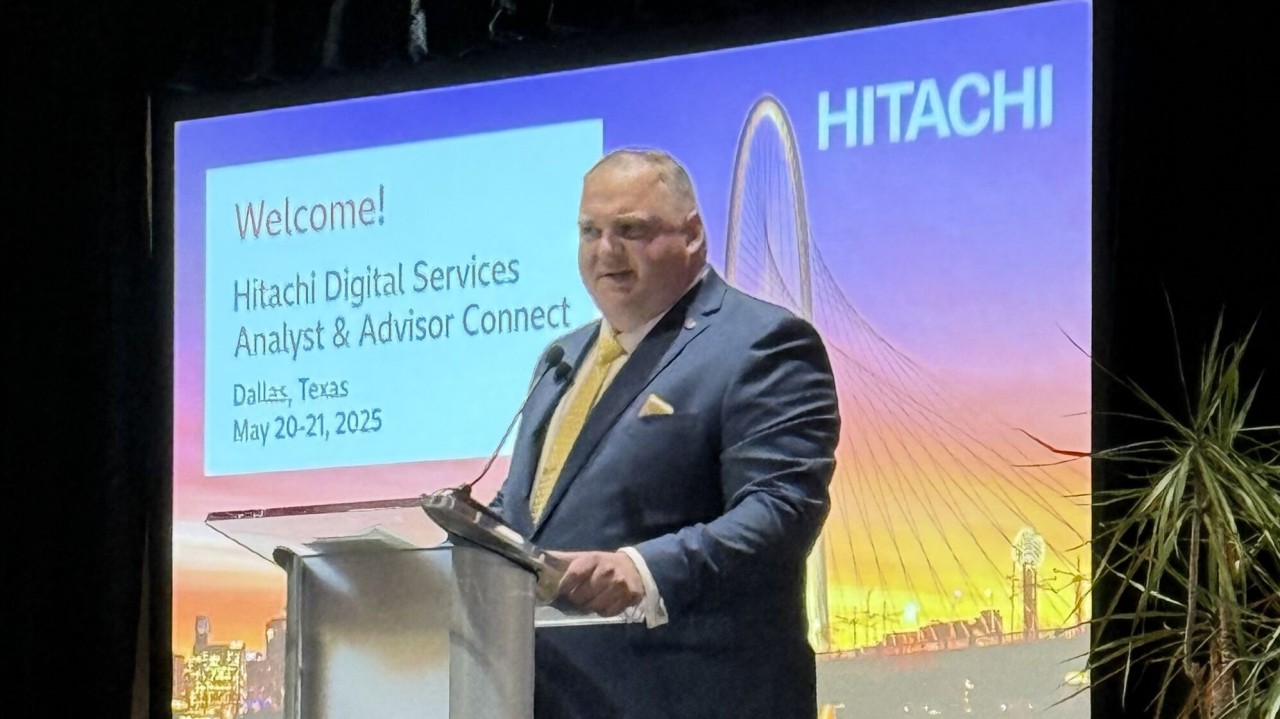
Transform Manufacturing by Enabling the Digital Thread
Digital transformation in manufacturing is no longer optional but an urgent imperative. Industry leaders recognize that embracing this shift is essential to sustaining profitability by eliminating inefficiencies, unlocking new revenue streams, and navigating an increasingly complex environment shaped by product complexity, regulatory pressures, and geopolitics. A foundational step in this journey is establishing a robust digital thread by integrating data across diverse software systems and physical equipment. This is where Hitachi Digital Services stands out. Leveraging deep engineering expertise honed through collaboration with sister companies renowned for their manufacturing excellence, Hitachi Digital Services brings a practical understanding of product development processes. Coupled with their PLM and MES implementation capabilities, they are uniquely positioned to help manufacturers drive digital transformation across the value chain.
Unlock Value through AI and Manufacturing Analytics
Manufacturers are increasingly prioritizing investments in AI and analytics. As highlighted in Tech-Clarity, Inc.'s research by Julie Fraser, Making Manufacturing Analytics and AI Matter, early adopters are already realizing significant gains, ranging from cost reduction and productivity improvements to enhanced quality, error-proofing, and better delivery performance. This space is a natural fit for Hitachi Digital Services, which showcased powerful use cases such as a rail application where edge computing in the train enables real-time data analysis from sensors monitoring track conditions and overhead power lines, directly enhancing safety outcomes. With modern factories generating massive volumes of data, Hitachi Digital Services is ideally positioned to help manufacturers harness this information to optimize energy usage, drive quality, and maximize overall equipment effectiveness.
Secure IT-OT Convergence
The convergence of Information Technology and Operational Technology is a strategic enabler for manufacturers seeking to enhance operational efficiency, reduce costs, improve decision-making, and drive innovation. However, the path to IT-OT integration is often hindered by legitimate #cybersecurity concerns. Cyber threats, including data breaches, IP theft, ransomware, and operational disruptions, pose significant risks to brand reputation and profitability. To fully capitalize on the promise of IT-OT convergence, cybersecurity must be embedded as a core foundation. Hitachi Digital Services brings deep cybersecurity expertise through its partnership with Hitachi Cyber, offering tailored protection strategies and best-practice implementations. Their ability to integrate security seamlessly into digital transformation initiatives, along with providing managed security services, makes them a trusted partner in securing the connected factory of the future.
Our Takeaways on Hitachi Digital Services
In conclusion, the Hitachi Digital Services Analyst event provided valuable insights into leveraging its deep engineering heritage and cross-division expertise to drive impactful digital transformation for its manufacturing customers. Their capabilities in enabling the digital thread, deploying AI and analytics, and securing IT-OT convergence align closely with the critical needs of manufacturers. We were especially impressed by their practical, field-tested approach and commitment to co-innovation. These strengths position Hitachi Digital Services as a trusted partner in helping manufacturers unlock efficiency, resilience, and innovation. We thank Patrick Corcoran and Mahesh Hanumanthu for the opportunity to participate in this event.
[post_title] => Hitachi Digital Services Analyst & Advisor Connect: Three Key Takeaways for Manufacturers [post_excerpt] => [post_status] => publish [comment_status] => open [ping_status] => open [post_password] => [post_name] => hitachi-digital-services-analyst-advisor-connect-2025 [to_ping] => [pinged] => [post_modified] => 2025-06-05 10:23:11 [post_modified_gmt] => 2025-06-05 14:23:11 [post_content_filtered] => [post_parent] => 0 [guid] => https://tech-clarity.com/?p=22088 [menu_order] => 0 [post_type] => post [post_mime_type] => [comment_count] => 0 [filter] => raw ) [3] => WP_Post Object ( [ID] => 22042 [post_author] => 2 [post_date] => 2025-05-21 10:00:58 [post_date_gmt] => 2025-05-21 14:00:58 [post_content] =>Tech-Clarity is pleased to announce that we are expanding our research team and extending our Manufacturing Operations and Manufacturing Technology coverage.
Well-known industry thought leader, keynote speaker, and research analyst Rick Franzosa is joining Tech-Clarity as Vice President of Research for Manufacturing. Rick brings decades of experience in Manufacturing Operations, specializing in Digital Transformation, Manufacturing Innovation, MES/MOM, Manufacturing Process Management (MPM), and other solution domains essential for manufacturers and supply chains. Please visit Rick's bio page for more details on his background. It's a challenging time for the manufacturing industries, and Rick is well-positioned to help manufacturers navigate change to help them drive new business value. Traditional manufacturing industries are undergoing significant changes due to a confluence of events, including supply chain volatility, the need to reduce product complexity, and to optimize portfolios in a rapidly changing world. Manufacturers must invest wisely to increase flexibility and agility while improving multicultural teams’ competency and decision-making skills. Leading manufacturers are adopting advanced technologies such as IIoT, connected factory worker platforms, Digital Twins, and Digital Threads, augmented by Artificial Intelligence. The goal is to bridge gaps between customer requirements management, product innovation, engineering product development, manufacturing operations, supply chains, and service. Today's leading software vendors are evaluating their product portfolio strategies, and new AI solutions are emerging as disruptors to meet these challenges.“This is a strategic move,” explains Jim Brown, President and Founder of Tech-Clarity. “As manufacturers grapple with rapid change while combating global pressures, it's imperative that we offer a broad perspective on digital transformation for 2025 and beyond. More than ever, we have to help companies understand and achieve technology's value by aligning technology with processes and people. Rick brings great experience, credibility, and a global perspective. We are excited to have such a respected thought leader join our team to help further our mission of making the business value of technology clear.”Rick's research focus will include the role of MES/MOM amidst a sea of new technologies from both end-user and technology provider perspectives. This includes how technology improves the decision-making skills and competency of the manufacturing workforce. Please reach out to schedule a briefing or seek out Rick’s perspective as he begins his research agenda. Join our community to follow Rick's research. [post_title] => Tech-Clarity adds Digital Innovation and Manufacturing Analyst Rick Franzosa [post_excerpt] => [post_status] => publish [comment_status] => open [ping_status] => open [post_password] => [post_name] => rick-franzosa [to_ping] => [pinged] => [post_modified] => 2025-06-17 11:31:27 [post_modified_gmt] => 2025-06-17 15:31:27 [post_content_filtered] => [post_parent] => 0 [guid] => https://tech-clarity.com/?p=22042 [menu_order] => 0 [post_type] => post [post_mime_type] => [comment_count] => 0 [filter] => raw ) [4] => WP_Post Object ( [ID] => 22023 [post_author] => 2572 [post_date] => 2025-05-20 10:00:45 [post_date_gmt] => 2025-05-20 14:00:45 [post_content] =>
 What should MedTech companies consider when integrating ALM and PLM?
Software has become a crucial component in MedTech products. However, with software development managed in Application Lifecycle Management (ALM) and hardware managed in Product Lifecycle Management (PLM), the separate systems can create silos within the product development team. With increasing regulatory pressures and trends such as personalized healthcare, it has become even more important to eliminate these silos and establish a digital thread across product development data.
In this 20-minute video, Michelle Boucher and PTC's Meg Folcarelli discuss key considerations for MedTech companies to support the co-development of hardware and software. They cover:
What should MedTech companies consider when integrating ALM and PLM?
Software has become a crucial component in MedTech products. However, with software development managed in Application Lifecycle Management (ALM) and hardware managed in Product Lifecycle Management (PLM), the separate systems can create silos within the product development team. With increasing regulatory pressures and trends such as personalized healthcare, it has become even more important to eliminate these silos and establish a digital thread across product development data.
In this 20-minute video, Michelle Boucher and PTC's Meg Folcarelli discuss key considerations for MedTech companies to support the co-development of hardware and software. They cover:
- Current product development trends affecting MedTech companies
- The challenges and impacts these trends pose for the industry
- Best practices to tackle these challenges
- What to prioritize when integrating ALM and PLM
- Implementation advice
Can agentic AI improve how people work on the factory floor? Can it address the workforce crisis that has resulted in a plateau in productivity and increasing safety incidents? OpsMate AI believes they can do that quickly with their no-code agentic AI platform, which is purpose-built for the complexity and high-stakes environment of manufacturing operations. Their approach is to use generative and agentic AI to create hyper-intelligent digital teammates that assist the factory workforce.
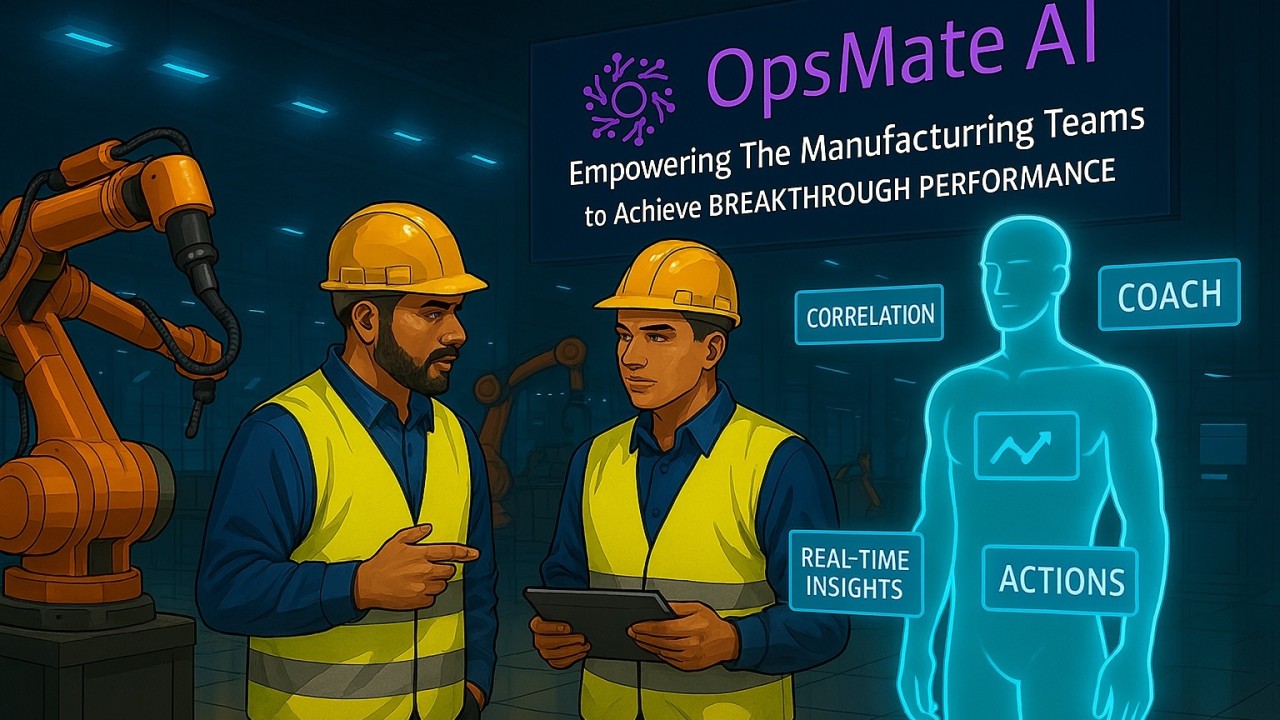 Flexible Knowledge Assistants
Flexible Knowledge Assistants
Agents have access to more information than a person could. The agent-as-assistant concept makes sense, particularly in the unpredictable world of day-to-day operations. No matter the level of skill or experience an operator or associate has, they can ask the agent and get not only data but information, knowledge, and reasoning. This is quite different from traditional hard-coded, pre-defined applications and dashboards.
The great news about genAI is that it can train on a wide variety of data. So, it can naturally bridge the IT/OT divide. Whether the data is from IoT, MES, a machine, SharePoint, or a Teams transcript, OpsMate AI can ingest it, bring it together, put it in context, and make it available in any language.
High-Value Use Cases
As with all genAI, these agents work with natural language queries, not through coding or formal queries. They can answer questions, guide work, perform analysis, or take on routine tasks. This early-stage company created an advisory board based on the founders’ deep existing manufacturing relationships.
This advisory board has pointed to the common use cases that they would find valuable in their workflows. Since then, the OpsMate AI team has been busy building their minimum viable product to address those needs. Some of the initial use cases involve acting as a virtual technician to support less experienced maintenance staff with what is otherwise tribal knowledge. Another use case seeks to replicate the EH&S expertise of front-line managers with agents mentoring the workers.
Layers of Knowledge
OpsMate AI points to 3 layers of knowledge: general, industry-specific, and customer-proprietary knowledge. OpsMate AI builds in the first two, but the customer keeps control of their own data. They get an instance and decide who has access to address security and privacy concerns. The customer-specific knowledge repository can come from existing documents (SOPs, manuals, checklists, drawings, troubleshooting logs, corrective action reports, etc.) Experts can also train the model through an interview and knowledge capture process where their expertise becomes encoded in agents.
Once the agent is trained on the appropriate knowledge collection, it can effectively perform its tasks. The digital workforce will be available for in-line, real-time guidance for anyone in the plant. It could be as simple as “What does this PLC error code mean?” or as complex as “How can I maximize yield?” The system will also be transparent in showing the source(s) of data that lead to its recommendations.

Autonomous Digital Workforce
OpsMate AI founders have developed a roadmap to an autonomous digital workforce, augmenting the people who remain at the center. They see robots doing physical work and OpsMate AI agents doing knowledge work. Over time, the agents can learn more and. progress from being virtual experts to analyzing data to executing tasks. At some point, they may fully automate tasks and become autonomous.
Possible Rapid Benefits
We see the possibility of this being a breakthrough for customers. Our research shows that GenAI can deliver significant benefits quickly. Systems that have been purpose-built as agents for factory floor issues, such as what OpsMate AI offers, are attractive because they have so much pre-built. Manufacturers seeking to shore up aspects of the operation that most need additional knowledge and expertise should take note.
Early Stage Progress
OpsMate AI has a strong base of advisory board manufacturers driving its initial product development. These companies have their data in it and are testing and helping refine it. We expect to see a commercial release around the middle of this year.
Thank you, Howard Heppelmann and James Zhang, for briefing us on your vision and early customer direction. We appreciate the pragmatic approach to agentic AI for production.
[post_title] => OpsMate AI Aims to Change Factory Work with Agentic AI [post_excerpt] => [post_status] => publish [comment_status] => open [ping_status] => open [post_password] => [post_name] => factory-agentic-ai [to_ping] => [pinged] => [post_modified] => 2025-06-05 10:43:27 [post_modified_gmt] => 2025-06-05 14:43:27 [post_content_filtered] => [post_parent] => 0 [guid] => https://tech-clarity.com/?p=22099 [menu_order] => 0 [post_type] => post [post_mime_type] => [comment_count] => 0 [filter] => raw ) [6] => WP_Post Object ( [ID] => 21977 [post_author] => 2 [post_date] => 2025-05-16 09:24:49 [post_date_gmt] => 2025-05-16 13:24:49 [post_content] =>
Rick Franzosa is the Vice President of Research for Manufacturing for Tech-Clarity. He covers MES/MOM and transitional technologies that support the evolution of manufacturing software technology into the age of Industry 4.0 and AI.
Rick has over 40 years of experience in manufacturing software technology, including 10 years as an analyst (Gartner) in addition to experience in design, manufacturing, and software engineering in aerospace and defense companies. He was involved in the early days of both PDM and shop floor solutions as they morphed into today’s PLM and MES solutions. He has a BS in Mechanical Engineering and an MBA from the University of Hartford.
Rick’s current areas of research include the role of MES/MOM in a sea of new technologies from both end-user and technology provider perspectives. This includes technology and how technology improves the decision-making skills and competency of the manufacturing workforce. He enjoys working with manufacturers and software solution providers on how to improve performance and create business value.
Rick enjoys spending time with his wife, children, and grandchildren. He also enjoys listening to and performing classic rock music and creating virtual models for train simulators.

Can you gain operational insights from AI without data scientists or programming? Can you do it at scale in a highly automated environment? TwinThread would say you can. Working to solve this challenge, the company is growing rapidly deploying its SaaS Industrial Digital Twin AI Platform. In November, they were 322 on the Deloitte Fast 500 Technology company list.
TwinThread offers a cloud-native SaaS AI platform based on a digital twin with pre-built applications. They claim these solutions connect rapidly to existing systems, often deliver insights within hours, and solve complex industrial problems within days. The improvement-focused offerings are designed for mid-size and large companies in two primary markets:
- process and hybrid manufacturing to improve production outcomes
- machine builders to monitor their equipment in the field.
Substantial Results
One pet food maker rolling out TwinThread globally reports that they are saving $1.3M per year based on a subscription cost of $108K/year by using the predictive quality module. Across five plants and 18 lines, the system recommends real-time changes in processes and ingredients. This enables the company to optimize the parameters that matter most to the quality of their products: moisture, fat, protein, and product density.
With a combination of current, in-context data and applications that support the most common issues facing these industries, the TwinThread customer base is growing. Some are rolling out and gaining ROI on problems they failed to address previously. Value can expand over time as the platform gains more data and customers add more use cases or applications, or moves to greater autonomy. The pet food company reports never again having a bad batch, and the Cpk or process quality index improved over 40%.
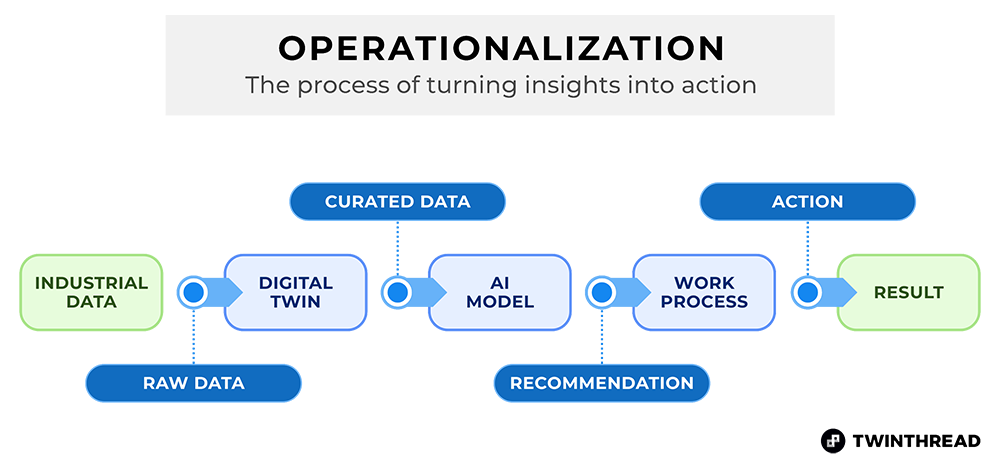
Virtual Operations Center
The founding vision is to offer a virtual operations center where people can monitor plants and lines worldwide. This enables customer companies to more fully leverage the scarce employees who have the most domain expertise. The pet food company achieved those results in the face of employee attrition, with operator experience dropping from 10 to 2 years.
As data comes in, it can support the continuous improvement cycle by monitoring, alerting to issues, recommending improvements, learning through machine learning, and solving problems. This virtual operations center can be a foundation for improving operational and business performance.
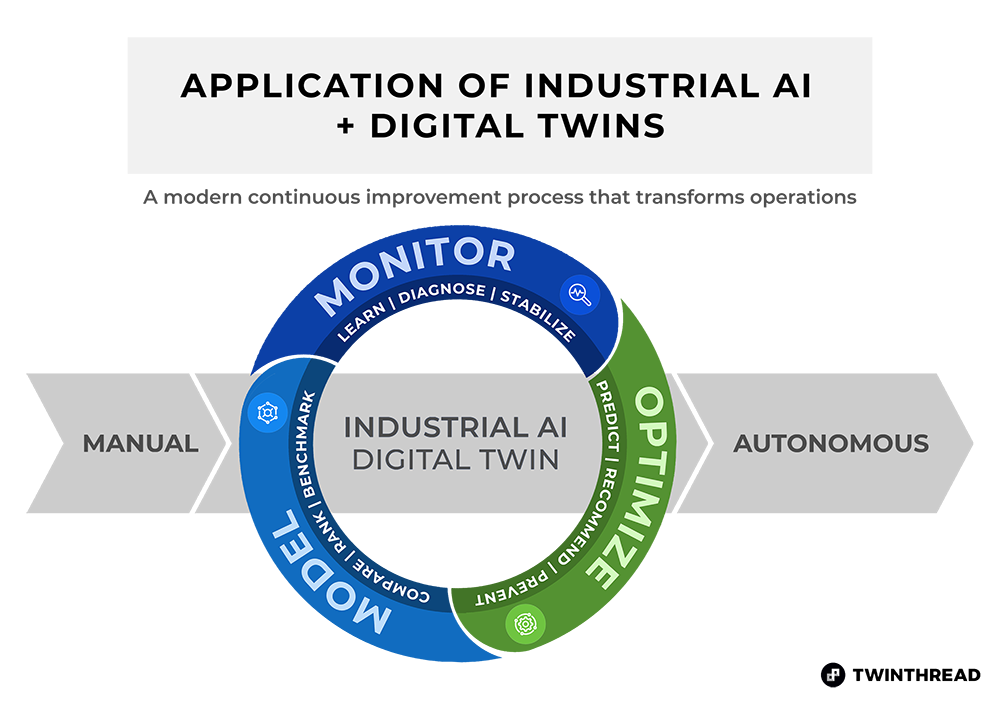
Growing Capabilities and Ecosystem
TwinThread was founded in 2017 to provide industrial data management and prebuilt solutions at the IT/OT intersection. They recently added the Enterprise Data Factory to deliver pre-curated big data sets for industrial or enterprise business intelligence. At this stage, the company has over a million process or operational digital twins in customer use. Each of those includes actual and historical plant data, not just a simulation.
Partnerships have been a hallmark of TwinThread’s strategy from its early days. The company now has over 400 channel partners, including GE and AVEVA. It has Transformation, System Integrator, Technology, and OEM partners. The latest announcement was with AWS for native integration to IoT SiteWise.
SaaS AI Platform
The Predictive Operations Platform is a SaaS Industrial Digital Twin AI Platform. It includes out-of-the-box connectors and agents or dockerized containers at the edge. It feeds that diverse data into a process digital twin at the core. On top of the twin, a thread engine layers additional context and visualization. The platform also includes logic streaming, the ability to build out if-then-else logic for event detection, and capabilities for data curation, cleaning, and orchestration of behaviors. The behaviors can be fully automated or deliver prompts for people.
Focused Applications
TwinThread sees that instability and variability are underlying problems for process and hybrid industries. As long-running processes often have inertia, optimizing them can be a challenge. So, the system focuses on helping companies identify the drivers of instability and move to a more consistent approach to running their production. The applications focus on both process-centric use cases and asset-centric use cases.
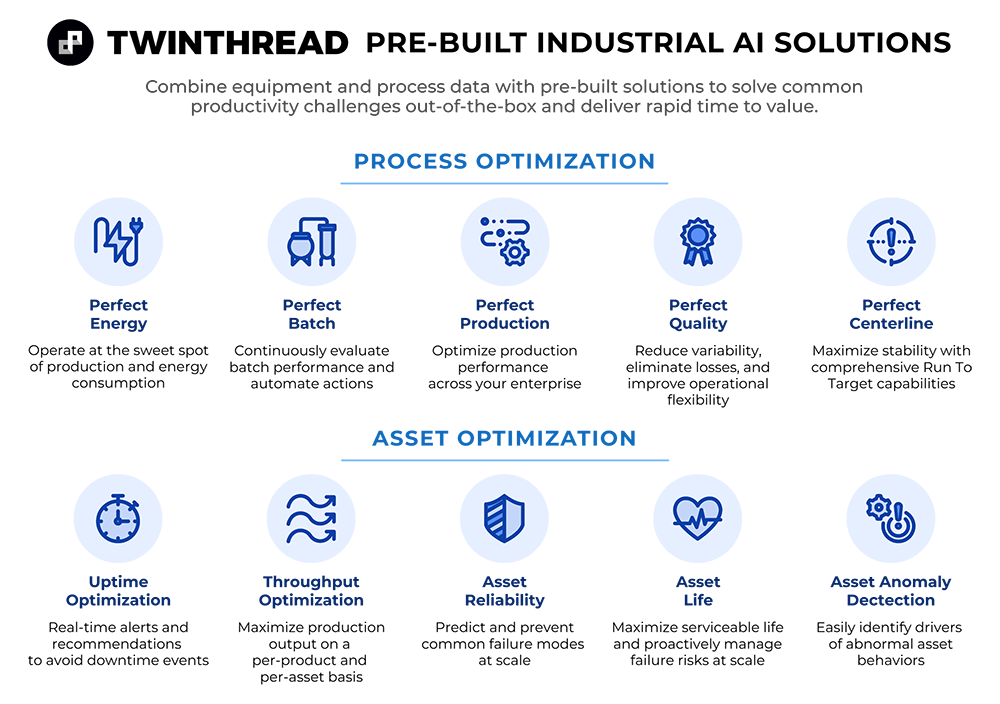
System Users
The users are operators, engineers, and digital teams. TwinThread calls the engineers and operations subject matter experts developers since they use TwinThread to mine data and solve problems without writing code. The operators are the customers of what they develop. Data scientists also use the platform to feed their tools, such as Jupyter Notebooks, to configure machine learning and data science workflows.
Deployment Approach
Enterprise-scale customers have typically failed more than once to scale with other approaches. Normally, TwinThread starts by defining success criteria for a three-month pilot on a single line and a few use cases. Their preferred approach is to mentor a process engineer to create the pilot themselves. By then, the customer understands how quickly and easily they can model their process in the digital twin and are typically in production and seeing benefits.
TwinThread’s comprehensive approach addresses people issues by enabling the process engineers to develop what they need and then having expert operations staff available in the virtual operations center to support the less experienced team members. The system maps processes in the digital twins, delivering inherent context to the data.
Deeply Experienced Team
TwinThread was founded by three successful pioneers in process and hybrid production software. They met at Mountain Systems, which became GE’s Proficy MES and Historian. The co-founders are Erik Udstuen, the CEO, Tom Nettell, the CTO (those two co-founded Mountain Systems in 1996), and Andrew Waycott, the President. The team includes long-time industry mavens Brandon Ekberg, one of the first MES experts, running Product, and Sheila Kester, ex-GE, Emerson, and Intellution, running operations. Jason Dietrich, as CRO, is a recent hire with deep experience in manufacturing software.
Thank You
Thank you, Sheila Kester, for setting up the briefing. Thanks also to Andrew Waycott, Marc Albu, Elise Loffredo, Jason Dietrich, and Brandon Ekberg for your time and insights in the briefing. We look forward to following TwinThread’s progress and continued profitable growth for the company and its customers.
[post_title] => TwinThread’s Industrial AI Platform and Apps Seeing Quick Results and Rapid Growth [post_excerpt] => [post_status] => publish [comment_status] => open [ping_status] => open [post_password] => [post_name] => saas-industrial-digital-twin-ai-platform [to_ping] => [pinged] => [post_modified] => 2025-11-03 19:15:43 [post_modified_gmt] => 2025-11-04 00:15:43 [post_content_filtered] => [post_parent] => 0 [guid] => https://tech-clarity.com/?p=22071 [menu_order] => 0 [post_type] => post [post_mime_type] => [comment_count] => 0 [filter] => raw ) [8] => WP_Post Object ( [ID] => 21955 [post_author] => 2 [post_date] => 2025-05-14 11:56:27 [post_date_gmt] => 2025-05-14 15:56:27 [post_content] =>
We had the chance to attend the Aras Community Event, ACE 2025, to hear strategy and progress updates from Aras Corporation, their customers, and their partners. It was exciting because it was the 25th Anniversary of ACE and the first time in memory that we’ve seen a keynote speech from a balcony ballroom seat! It was a unique venue for a unique company in the PLM space.
Our key takeaways are that Aras is successfully delivering across the elements of what makes them unique, what’s known as “The Aras Effect.” Beyond those core fundamentals, Aras showcased strong customer success stories and progress on delivering new AI capabilities that will become increasingly important to both customers and the market in the future.
The Aras Effect - What Makes Aras Unique
We’ve always seen Aras as a disruptor in the PLM space and believe that manufacturers looking for PLM – or to augment their current PLM solution – should understand what makes them different. This difference got a name and a more formal definition last year, “the Aras Effect,” what I previously called the “Aras difference” in a 2023 post.

But it’s more than a name on a marketing slide, it’s a way to better encapsulate the unique value proposition that Aras brings to the market and their customers. We won’t share it all here, but there are two things that are important to understand:
- Why it matters: Quoting from last year’s ACE writeup, companies looking for a PLM system “should include Aras in their research, not because they are necessarily a better offering but because they are a very different offering. They aren’t the right fit for every organization, but their approach is compelling and high value for the right companies.”
- Aras is delivering on the promise: Aras is walking the talk with this strategy and delivering against its tenants. We’ll discuss each of those in this post.
What we saw at ACE this year was Aras staying the course on these core differentiators and making progress to deliver them more fully to their customers. We’ll share a couple of specific examples, specifically the new product Aras InnovatorEdge and the continued growth in the Build with Aras.
InnovatorEdge Expands Connectivity
One of the biggest value drivers of any PLM system is creating a cohesive, integrated digital thread of product data. That data extends beyond engineering, spanning the enterprise and the supply chain. Manufacturers have stopped looking for a magic PLM system that contains all possible digital thread data. Instead, the industry has matured to recognize that digital thread data will reside across multiple enterprise systems. InnovatorEdge is designed to address that reality.
We like how Aras CTO Rob McAveney introduced InnovatorEdge by asking how customers can extend the reach of their digital thread beyond the walls of their company into the supply chain / value chain, into more phases of product lifecycle, and to more disciplines. This closely reflects the value we see Top Performing manufacturers seek in what we call the Four Dimensions of PLM Expansion. We also recognize the need for integration to support this. In fact, our recent renditions of the framework include an integration layer around the edge.

Rob explains that to accomplish this, you need the Aras Effect. And in particular, you need the new Aras InnovatorEdge low-code API management framework.

Aras InnovatorEdge is intended to help manufacturers develop connected intelligence and has four primary elements:
- Connections: Increasing the ability to integrate Aras Innovator with the ecosystem of other systems that support the digital thread via low-code API web services
- AI & Analytics: More on that later
- Portals: Expanding the ability to connect digital thread data to partners. This started with the Supplier Portal introduced last year and has now been expanded to support other entities that contribute and consume digital thread data
- Apps: Providing tools to help customers develop purpose-built, low-code apps that leverage Aras Innovator data and capabilities, including (as we understand) composite applications that allow apps to connect with 3rd party solutions
This is just a short introduction to InnovatorEdge. The offering creates a home for some existing capabilities and incorporates new features. Together, it creates a framework for Aras to continue to deliver additional capabilities to meet customer needs beyond what’s included in Aras Innovator.
Build with Aras Continues to Prove the Value of Adaptability
Aras also shared updates that show they are progressing their ability to enable customers to be agile. Agility is arguably more important to manufacturers today than it has been in years. Further, no one company’s PLM needs are exactly the same and creating a competitive advantage often means doing something differently than others do it. At the same time, it’s best to start with best practices.
One of the most unique aspects of Aras Innovator is that it was built with customization in mind. In recent years, we’ve seen Aras double down on this differentiator while also making it easier for their customers to customize their PLM solution and maintain it over time. In addition, they’ve invested in their marketplace to help customers and partners deliver custom-built capabilities to others. “Build with Aras” encapsulates this.

Aras customers shared some significant successes in this area. One of the areas that’s been personally interesting to us is the ability for customers with formula-based products to customize Innovator to meet their needs. Aras now supports food and beverage companies, including Red Bull and some breweries. Aras’ core capabilities can also be expanded by a solution in their marketplace, Fulvisol Food & Beverage, designed to meet the unique PLM needs of the food and beverage industry. This has been traditionally difficult for PLM companies built for bill-of-material oriented, discrete manufacturing environments. We’re keeping a close eye on this space
We’ve seen Aras make interesting advances in this area. For example, they continue to enhance their low-code capabilities and their low-code CAD connectors. One of the interesting advances also relates to Aras’ move to a SaaS offering. Aras has invested heavily in a DevOps environment for themselves and their customers to develop, deploy, and maintain their custom and marketplace applications. They introduced a low-code DevOps that will be coming soon in a beta that is designed to make it easier for non-developers who don’t know Git and related processes to manage the process.
Powered By Continues to Prove the Value of Community
One of the very unique ways that Innovator’s “Build With” adaptability comes to market is through their “Powered By” strategy. Aras has made their Innovator platform available for partners to use as the basis for their own solutions. Examples of commercial offerings built on top of Aras Innovator include:
- Ansys Minerva: a simulation process and data management (SPDM) solution
- AVEVA ALM: asset lifecycle management (ALM) solutions
- SAIC ReadyOne: digital engineering solution meeting DoD requirements

Beyond these, Aras and Sandvik jointly announced a new partnership to use Aras Innovator as the foundation for MasterCAM CAM data management and to further connect the product digital thread. In a similar way, Steepgraph is offering Scale B, a solution leveraging Aras Innovator designed for small to medium sized manufacturers. Each of these solutions fills an important niche in the industry and leverages rich capabilities already built into Innovator.
New Focus on AI
 No software conference is complete without an update on what the vendor is doing about AI. As experienced analysts, we could be jaded about that. After all, AI is not brand new and we’ve been using it in engineering and manufacturing for decades. However, we do believe there is a fundamental shift that software vendors must explore for their customers. Our recent research shows three important things:
No software conference is complete without an update on what the vendor is doing about AI. As experienced analysts, we could be jaded about that. After all, AI is not brand new and we’ve been using it in engineering and manufacturing for decades. However, we do believe there is a fundamental shift that software vendors must explore for their customers. Our recent research shows three important things:
- Manufacturers are planning to invest in AI
- They are gaining rapid business value from adopting AI
- They would prefer to get AI solutions from their current software vendors
Given that, our viewpoint is similar to the stance we took on the cloud transition. Even if a customer wasn’t interested in transitioning to the cloud, we believed it was important for their vendor to have a cloud strategy to remain viable in the future. Today, if a vendor doesn’t have an AI strategy and isn’t making progress, their customers should be concerned. From what we can tell, Aras customers should be satisfied with what they see.
The theme of ACE 2025, Connected Intelligence, focused on the AI imperative. Aras CEO Roque Martin kicked off the conversation about AI early. There was also a fascinating panel discussing the topic. Rob McAveney shared more details about the strategy breaking it into three phases:
- Discover: helping customers learn more from their data, mentioning examples including ECO phase in, component supply, and root cause analysis
- Enrich: more advanced capabilities providing entity recognition, contextual reasoning, topic modeling, and learning, mentioning examples including identifying and correcting missing or incorrect links in a digital thread and linking factory floor data to quality planning parameters
- Amplify: expanding to capabilities like agentic AI and generative learning, mentioning examples including using AI to build common variability model (breakdown structure) from past engineering work or conduct ECO impact analysis
Tangible examples of Aras’ investment are the new Aras AI Assistant, a chatbot currently in beta, created to help users access information in Aras Innovator. This capability will extend to custom capabilities and integrations in the future to support Build By. They also announced Aras AI-assisted Search, available later this year, that provides rich information including 3D data, images, and voice search results filtered on their semantic meaning. Aras is also working on CoPilot and AgenticAI technology, and we expect to see announcements from them in these areas soon.
Microsoft as Partner and Customer
While we’re speaking about AI, it’s a good time to mention the unique relationship Aras has with Microsoft. On one hand, Aras is a partner that strongly leverages Microsoft technologies. This has significant implications for Aras in AI because of Microsoft’s investments in Microsoft Azure AI tools. In addition, Microsoft is a customer that uses Aras Innovator to help them develop and manage their hardware products, including Surface, Xbox, and quantum products. They also use it for Azure servers and racks. They’re a significant customer, with over 800 users per day on average, including many outside of engineering, including sourcing, legal, and product management.

With that said, Microsoft’s presentation on what they’ve done for themselves with AI on top or Aras Innovator is one of the most compelling examples we’ve seen of a manufacturer using AI to extend the value of PLM. The Microsoft team shared three compelling examples:
- Someone from Legal looking for information on packaging compliance for a part
- An engineer considering sustainability for carbon and recycled material, but needing to do tradeoff analysis with cost, supply chain, etc.
- Reducing the time it takes to execute an ECO by handling repetitive tasks like looking for components that are end of life (EOL)
These are all practical examples where Microsoft used AI, which they view as “just a tool,” for practical purposes and meaningfully improved efficiency.
Other Notes
There is too much to include from the conference, but some other takeaways we want to mention include:
- CERN’s David Widegren explained how they use Aras Innovator to develop and manage the “world’s most complex machine,” the Large Hadron Collider, including their creation of a digital twin that provides 3D navigation based on data in Aras combined with other data. It’s an impressive implementation.
- Honda’s Tomoya Isome and Nobuyuki Akahoshi shared information about their Aras Innovator implementation that they have scaled to “tens of thousands of users.”
- Aras’ SVP Igal Kaptsan reviewed recent user-led enhancements to Innovator including user interface updates in beta, unified change management, requirements management, and updates to the Office productivity connector among others. Aras has been investing in maturing the product overall.
Our Take
Aras Innovator is a very different style of solution than most enterprise systems, and any other PLM system, due to its adaptability. While that’s not the right solution for every business, the Aras Effect offers an alternative that some manufacturers find compelling. Aras is doubling down on their differentiators, maturing the existing solution, helping further connect digital threads across the value chain with InnovatorEdge, and investing in new areas like requirements management and AI. The conference showed continued progress against the Aras strategy.
Thank You
Thank you Roque Martin, Rob McAveney, and Igal Kaptsan for the business and product updates and to Josh Epstein , Bruce Bookbinder , Jason Kasper , Kylie Ochab, and others for informal conversations and help along the way.
[post_title] => Aras Delivers on Promises, adds Focus on AI [post_excerpt] => [post_status] => publish [comment_status] => open [ping_status] => open [post_password] => [post_name] => aras-ace-2025 [to_ping] => [pinged] => [post_modified] => 2025-07-22 10:17:25 [post_modified_gmt] => 2025-07-22 14:17:25 [post_content_filtered] => [post_parent] => 0 [guid] => https://tech-clarity.com/?p=21955 [menu_order] => 0 [post_type] => post [post_mime_type] => [comment_count] => 0 [filter] => raw ) [9] => WP_Post Object ( [ID] => 21924 [post_author] => 2 [post_date] => 2025-05-14 09:00:46 [post_date_gmt] => 2025-05-14 13:00:46 [post_content] => Jim Brown is moderating an AMC Bridge Expert Panel discussion on AI progress in industry. Has AI delivered on the hype? Are manufacturing and AEC companies adopting AI-driven use cases that drive real business value? Have we moved beyond the proof-of-concept phase in AI adoption?
The panel will discuss these questions and more to shed light on the progress made since our prior panel on the topic. Jim will share recent research and insights on AI progress, adoption, and value while leading a lively conversation with panelists who are actively helping move the needle on AI value. Jim will be joined by:
Jim Brown is moderating an AMC Bridge Expert Panel discussion on AI progress in industry. Has AI delivered on the hype? Are manufacturing and AEC companies adopting AI-driven use cases that drive real business value? Have we moved beyond the proof-of-concept phase in AI adoption?
The panel will discuss these questions and more to shed light on the progress made since our prior panel on the topic. Jim will share recent research and insights on AI progress, adoption, and value while leading a lively conversation with panelists who are actively helping move the needle on AI value. Jim will be joined by:
- Dan Williamson, Director of AI, Ryan Companies
- Anthony Hauck, Co-Founder and Chief Product Officer, Hypar
- Patrick Murphy, CEO and Founder, Togal.AI
- Igor Tsinman, Co-Founder and President, AMC Bridge

We were recently alerted to a company we weren’t covering because a long-time business friend took a key position there. After a quick review of what they do, Julie Fraser and Jim Brown decided to team up on the briefing because we could already see a combination of QMS and PLM capabilities. We learned that there was even more there than we initially thought, with some capabilities that you might expect from ERP and MES systems.
Yet, Enlil is not trying to be all those things to all people. Instead, they aim to be an integrated solution that supports the core needs of a specific audience, the early and mid-stage medical device ecosystem of product developers and contract manufacturers. Their sweet spot, by design, is supporting the varied and nuanced needs of medical device companies as they scale and seek regulatory clearance or approval. They’ve also discovered that contract manufacturers in the life sciences ecosystem find value in what they do. Enlil’s mission is to “empower MedTech product innovators to bring life-changing products to market faster, and with unwavering regulatory confidence.”
The Value of Specialized Solutions
Let’s step back to talk about product specialization. We talk about specialized solutions because nobody likes to be called a niche offering. They feel “niche” limits their potential. Regardless of what you call it, solutions built for a specific customer profile can be immensely valuable because they just fit the customers’ needs. Enlil, Inc. positions itself as a vertical SaaS solution for regulated products. In this case, it’s intrinsic to where Enlil came from and their mission. We feel it’s led to a unique offering with an excellent fit for smaller teams, whether they are startups or focused teams in larger enterprises, focused on developing pre-clinical, class 2 and 3 medical devices.
How Enlil Came to Be
The history is important. Enlil was not created as a startup software company looking for a problem to solve. Instead, Enlil is a purpose-built solution that grew out of an innovation hub that is part of the Shifamed Group. In this scenario, their first customers were their sister companies in the innovation accelerator. This not only helped create focus, but also helped ensure that user needs were met across a variety of similar startup medical device businesses. The result is that they are unique because of where they come from, who they serve, and what they do. Now, they have assembled an impressive team of industry veterans from the ERP, PLM, and MES industries to help grow the business.
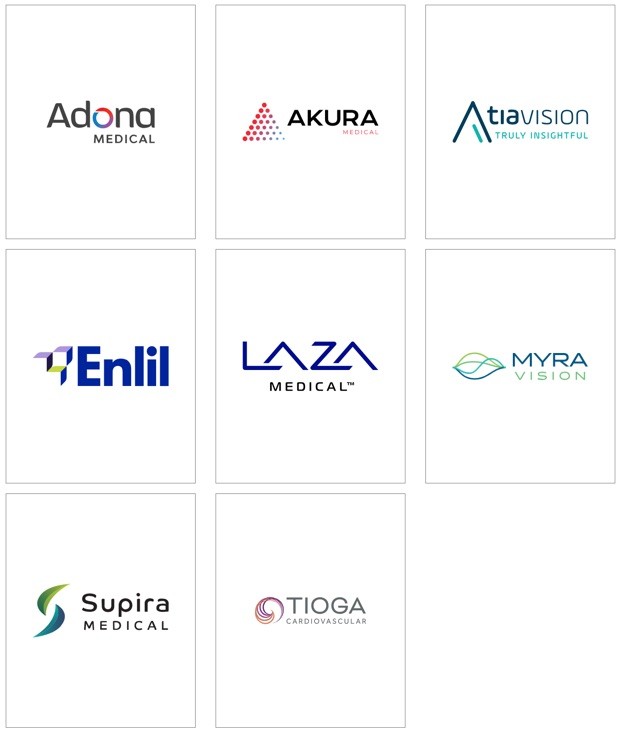
What is Enlil?
The best way to answer what Enlil is, is by who they support. It’s not a cookie-cutter product that was designed to meet the top ten features of PLM, QMS, MES, or another software category. What we saw was an end-to-end, collaborative product development and innovation system that supports digital thread traceability for medical devices. That’s hard to fit on a marketing slide, but the customer profile focus is the value. What they’ve done is identify the essential needs of their sister companies to use as guiding requirements for the solution.
That leads to an interesting solution that handles QMS functions like traceability and documentation. They can document test results, but they’re not trying to be a LIMS. They manage the digital thread across both hardware and software components, but they aren’t a full PLM system. They manage materials and clinical supply, but they don’t want to become an ERP system. That makes Enlil hard to classify. Are they a PLM with some MES capabilities, a QMS with some PLM functionality? But trying to classify them misses the point. Enlil is a specialized solution tailored to meet the product innovation and product development needs of early-stage medical device developers and their ecosystem.
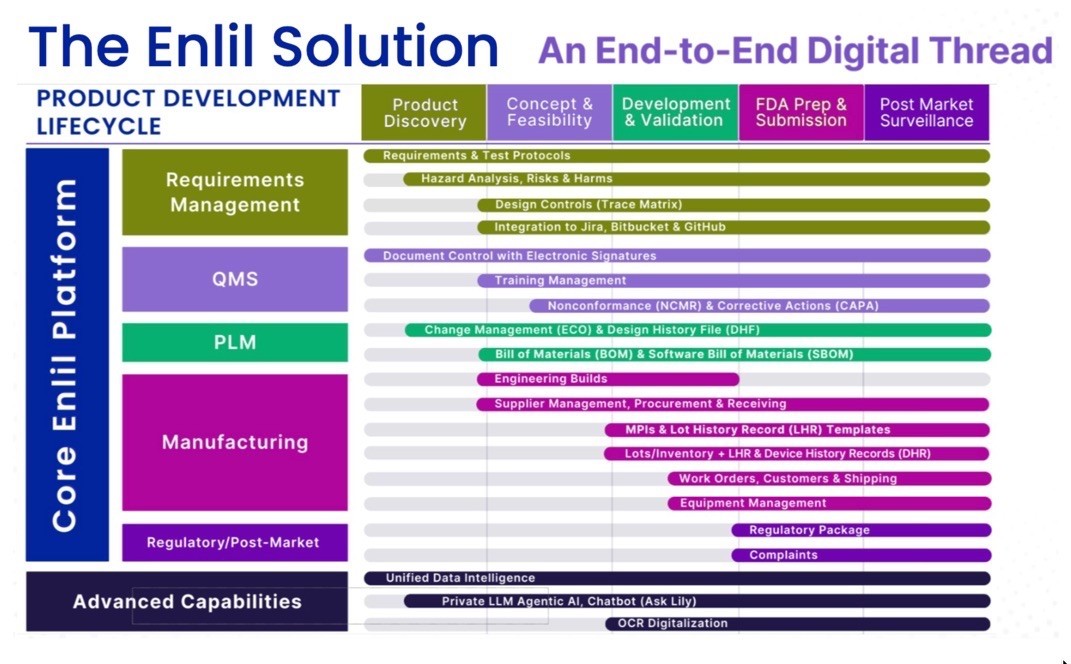
Who Enlil Targets
As mentioned, Enlil is a specialized offering. The customers that they see as the best bit for their capabilities are these profiles in the medical device ecosystem:
- Small and mid-sized MedTech companies
- Innovation hubs
- MedTech contract manufacturers
They have specialized capabilities that make these companies a good fit, including an interesting two-tier structure that allows innovation hubs, parent companies, or OEMs to share information and collaborate with related entities like incubated startups, product teams, or contract manufacturers. They’re also planning to release an AI chatbot, “Lilly,” to summarize information and help reduce the significant amount of manual work companies spend on regulatory documentation.
There is room for growth beyond these targets, for example, smaller development teams in larger enterprises, but the market they target today is a rich and exciting one. And, one that should appreciate Enlil’s focus.
Our Take
This writeup doesn’t share a lot of details about what Enlil does. Unapologetically, that is because their feature list isn’t what’s important, it’s their specialization on a target profile. Medical device companies looking for a single solution to meet their basic product development and traceability needs should take a look at Enlil. Startups in the medical device industry, who are looking to develop their products and get regulatory approval from the FDA should definitely see how Enlil could help them. It’s rare to find such a tailored solution for a specific set of customers to solve a specific collection of problems. Enlil may not stop there, but they are positioned well to get a strong foothold in early medical device development.
Thank You
Thank you Nader Fathi, Andrew Robbie , Christine Pearsall for introducing us to Enlil and your unique offering. We are excited to learn more and hear from the companies using your solution.
[post_title] => Enlil Focuses on Accelerating Medical Device Innovation with Compliance [post_excerpt] => [post_status] => publish [comment_status] => open [ping_status] => open [post_password] => [post_name] => medical-device-innovation [to_ping] => [pinged] => [post_modified] => 2025-07-23 09:46:29 [post_modified_gmt] => 2025-07-23 13:46:29 [post_content_filtered] => [post_parent] => 0 [guid] => https://tech-clarity.com/?p=21958 [menu_order] => 0 [post_type] => post [post_mime_type] => [comment_count] => 0 [filter] => raw ) [11] => WP_Post Object ( [ID] => 21857 [post_author] => 2574 [post_date] => 2025-05-08 09:00:36 [post_date_gmt] => 2025-05-08 13:00:36 [post_content] =>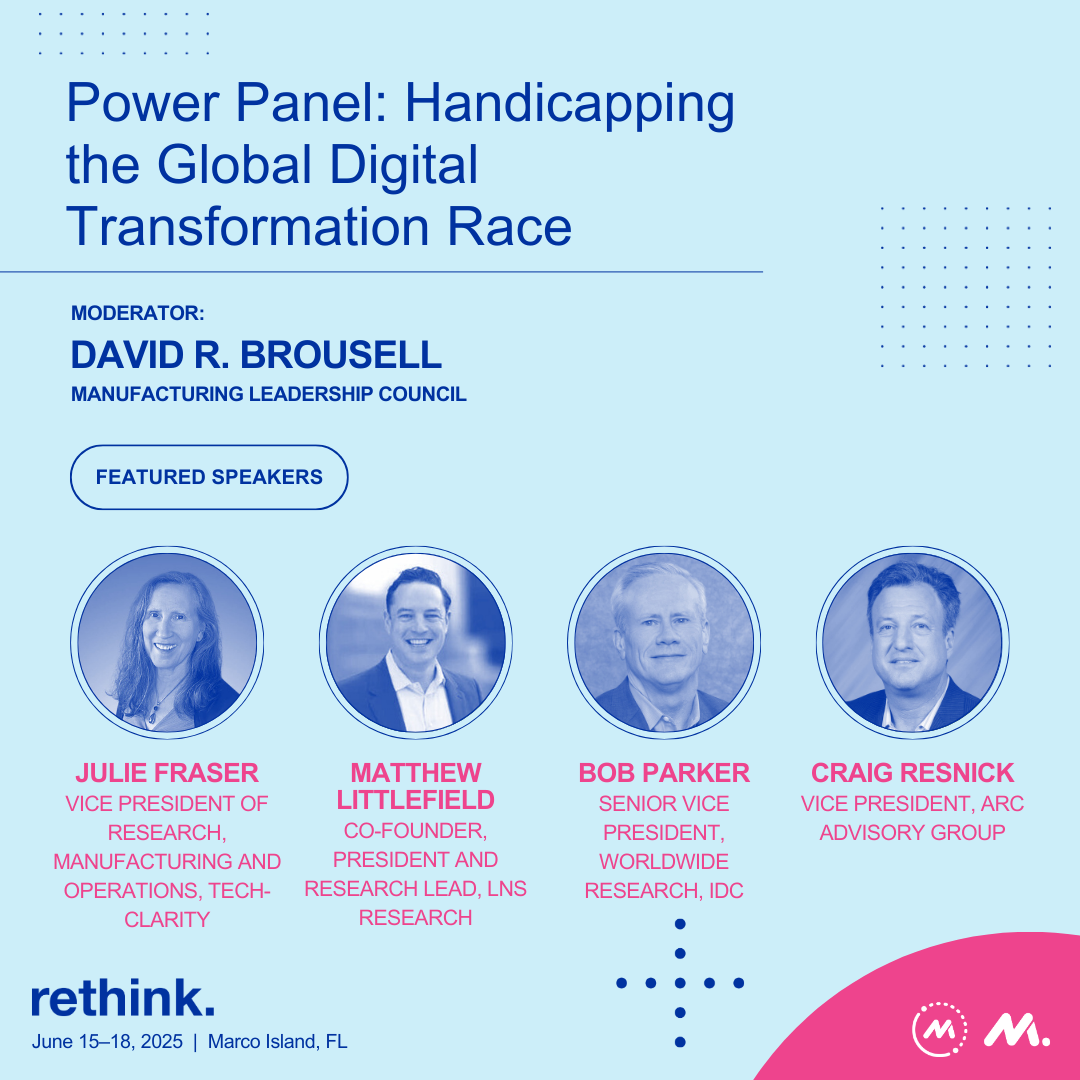 How are manufacturers doing at global Digital Transformation? What could accelerate progress? These are a few of the questions that Julie Fraser and other experienced industry analysts will discuss on a panel on June 17th. The session is part of the Manufacturing Leadership Council’s (MLC) Rethink Conference on Marco Island, Florida, and supports its theme, Accelerating Digital Transformation in Manufacturing.
This “Power Panel” will leverage research from four analyst firms to explore the current state of Digital Transformation in manufacturing. Joining the panel are Tech-Clarity’s Julie Fraser, Bob Parker of IDC, Craig Resnick of ARC, and Matt Littlefield of LNS Research. The panel moderator is David Brousell, Director and Founder of the MLC, which is part of the National Association of Manufacturers.
The panel will also address “handicapping” questions such as: What is the picture for global digital transformation in manufacturing? Are some regions ahead of others? If so, why? And questions about the path forward such as: What’s needed to move to the next stages of maturity? Are we ready to move from Industry 4.0 to Industry 5.0? These four long-time manufacturing software industry analysts will each contribute their opinions and share insights.
This panel is just a part of this dynamic in-person conference. The program includes a wide array of presentations, panel discussions, case studies, and networking sessions on culture, leadership, process, and technology. Topics range from what to expect in the economy to emotional intelligence for a thriving culture to defining the human-machine relationship to digital transformation for small and medium manufacturers. There is also an exhibit hall for sponsors to show their offerings on Tuesday and Wednesday.
Rethink runs from Sunday evening June 15th happy hour and then has three days of content. It ends with the black-tie Manufacturing Leadership Awards gala on Wednesday evening June 18th. The many categories of awards showcase what leading manufacturers are doing in AI Vision and Strategy, Business Model Transformation, Collaborative Ecosystems, Digital Supply Chains, Engineering, Production, and Integration Technology, Operational Excellence, Sustainability and the Circular Economy, and Transformational Business Cultures. There are also individual awards.
The MLC website describes the event: “Rethink examines today’s digital factory as it intersects with technology, organizations, and leadership. Come away with a better understanding of the smart factory and what’s needed to compete, succeed, and thrive in the connected future.” Last year’s event was compelling, and the topic for this year is global digital transformation. If you are attending, please let Julie know to set up some time to get face-to-face.
[post_title] => Power Panel: Handicapping the Global Digital Transformation Race
[post_excerpt] =>
[post_status] => publish
[comment_status] => open
[ping_status] => open
[post_password] =>
[post_name] => global-digital-transformation
[to_ping] =>
[pinged] =>
[post_modified] => 2025-05-08 09:42:18
[post_modified_gmt] => 2025-05-08 13:42:18
[post_content_filtered] =>
[post_parent] => 0
[guid] => https://tech-clarity.com/?p=21857
[menu_order] => 0
[post_type] => post
[post_mime_type] =>
[comment_count] => 0
[filter] => raw
)
[12] => WP_Post Object
(
[ID] => 21886
[post_author] => 2
[post_date] => 2025-05-07 08:30:37
[post_date_gmt] => 2025-05-07 12:30:37
[post_content] =>
How are manufacturers doing at global Digital Transformation? What could accelerate progress? These are a few of the questions that Julie Fraser and other experienced industry analysts will discuss on a panel on June 17th. The session is part of the Manufacturing Leadership Council’s (MLC) Rethink Conference on Marco Island, Florida, and supports its theme, Accelerating Digital Transformation in Manufacturing.
This “Power Panel” will leverage research from four analyst firms to explore the current state of Digital Transformation in manufacturing. Joining the panel are Tech-Clarity’s Julie Fraser, Bob Parker of IDC, Craig Resnick of ARC, and Matt Littlefield of LNS Research. The panel moderator is David Brousell, Director and Founder of the MLC, which is part of the National Association of Manufacturers.
The panel will also address “handicapping” questions such as: What is the picture for global digital transformation in manufacturing? Are some regions ahead of others? If so, why? And questions about the path forward such as: What’s needed to move to the next stages of maturity? Are we ready to move from Industry 4.0 to Industry 5.0? These four long-time manufacturing software industry analysts will each contribute their opinions and share insights.
This panel is just a part of this dynamic in-person conference. The program includes a wide array of presentations, panel discussions, case studies, and networking sessions on culture, leadership, process, and technology. Topics range from what to expect in the economy to emotional intelligence for a thriving culture to defining the human-machine relationship to digital transformation for small and medium manufacturers. There is also an exhibit hall for sponsors to show their offerings on Tuesday and Wednesday.
Rethink runs from Sunday evening June 15th happy hour and then has three days of content. It ends with the black-tie Manufacturing Leadership Awards gala on Wednesday evening June 18th. The many categories of awards showcase what leading manufacturers are doing in AI Vision and Strategy, Business Model Transformation, Collaborative Ecosystems, Digital Supply Chains, Engineering, Production, and Integration Technology, Operational Excellence, Sustainability and the Circular Economy, and Transformational Business Cultures. There are also individual awards.
The MLC website describes the event: “Rethink examines today’s digital factory as it intersects with technology, organizations, and leadership. Come away with a better understanding of the smart factory and what’s needed to compete, succeed, and thrive in the connected future.” Last year’s event was compelling, and the topic for this year is global digital transformation. If you are attending, please let Julie know to set up some time to get face-to-face.
[post_title] => Power Panel: Handicapping the Global Digital Transformation Race
[post_excerpt] =>
[post_status] => publish
[comment_status] => open
[ping_status] => open
[post_password] =>
[post_name] => global-digital-transformation
[to_ping] =>
[pinged] =>
[post_modified] => 2025-05-08 09:42:18
[post_modified_gmt] => 2025-05-08 13:42:18
[post_content_filtered] =>
[post_parent] => 0
[guid] => https://tech-clarity.com/?p=21857
[menu_order] => 0
[post_type] => post
[post_mime_type] =>
[comment_count] => 0
[filter] => raw
)
[12] => WP_Post Object
(
[ID] => 21886
[post_author] => 2
[post_date] => 2025-05-07 08:30:37
[post_date_gmt] => 2025-05-07 12:30:37
[post_content] => Jim Brown's recently published eBook research, The Business Value of An Industrial System of Engagement Platform, introduced the concept of the Industrial System of Engagement (SOE). Following the eBook, he penned a guest post for Hexagon summarizing the eBook and how the Industrial SOE provides a platform to extend the value of current enterprise systems by providing enhanced connectivity and collaboration.
The Industrial SOE
The post shares the challenge that manufacturers face – plenty of data but significant difficulty connecting and collaborating on the product digital thread information it holds. The eBook proposes that it’s time for manufacturers to change how they connect and collaborate across the systems that house their product data. Beyond sharing the challenges, the post offers a definition for the Industrial SOE and what it must deliver, including:- Data Centricity
- Integrated Information
- Operationalized Collaboration
- A System for Action
Hexagon’s Nexus Platform
This guest post shares an overview of the Industrial SOE concept based on our research and interviews with two thought leaders, Style Crest Project Engineer Tyler Lucas and Paragon Medical Devices Senior Quality Manager Jeff Livingston. It then discusses how Nexus, Hexagon’s open digital industrial platform for manufacturers built on the Microsoft Azure platform, delivers collaboration value for manufacturers.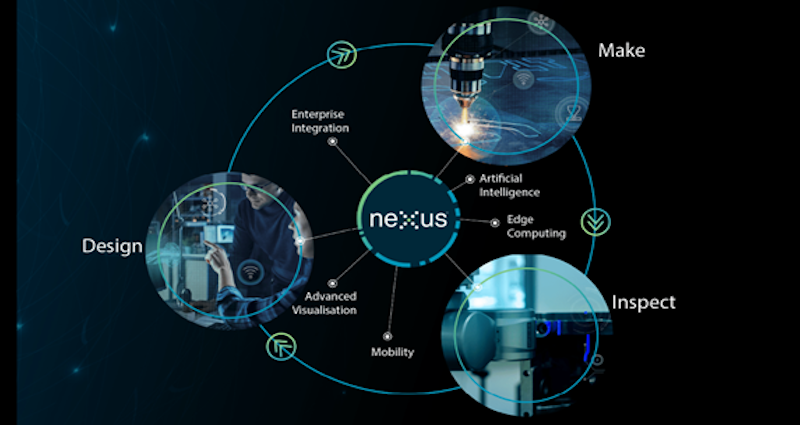 For more information on the Industrial SOE and Nexus, you can read the full blog post on the Hexagon site. You can also download the full white paper directly from Hexagon.
[post_title] => Hexagon Delivers a New Digital Industrial Platform to Accelerate Innovation
[post_excerpt] =>
[post_status] => publish
[comment_status] => open
[ping_status] => open
[post_password] =>
[post_name] => industrial-soe
[to_ping] =>
[pinged] =>
[post_modified] => 2025-05-07 14:02:16
[post_modified_gmt] => 2025-05-07 18:02:16
[post_content_filtered] =>
[post_parent] => 0
[guid] => https://tech-clarity.com/?p=21886
[menu_order] => 0
[post_type] => post
[post_mime_type] =>
[comment_count] => 0
[filter] => raw
)
[13] => WP_Post Object
(
[ID] => 21911
[post_author] => 2
[post_date] => 2025-05-06 10:00:02
[post_date_gmt] => 2025-05-06 14:00:02
[post_content] =>
For more information on the Industrial SOE and Nexus, you can read the full blog post on the Hexagon site. You can also download the full white paper directly from Hexagon.
[post_title] => Hexagon Delivers a New Digital Industrial Platform to Accelerate Innovation
[post_excerpt] =>
[post_status] => publish
[comment_status] => open
[ping_status] => open
[post_password] =>
[post_name] => industrial-soe
[to_ping] =>
[pinged] =>
[post_modified] => 2025-05-07 14:02:16
[post_modified_gmt] => 2025-05-07 18:02:16
[post_content_filtered] =>
[post_parent] => 0
[guid] => https://tech-clarity.com/?p=21886
[menu_order] => 0
[post_type] => post
[post_mime_type] =>
[comment_count] => 0
[filter] => raw
)
[13] => WP_Post Object
(
[ID] => 21911
[post_author] => 2
[post_date] => 2025-05-06 10:00:02
[post_date_gmt] => 2025-05-06 14:00:02
[post_content] => The Value of AI in Manufacturing is Accelerating
There is a lot of talk about the value of artificial intelligence in manufacturing, and rightfully so. Although AI isn't new, it appears to be reaching a tipping point where companies are more open to exploring its potential and AI techniques are more accessible than ever. Manufacturers are acting on the opportunity. Our recent Making Manufacturing Analytics and AI Matter research, for example, shows that 99% of manufacturers plan to invest in analytics and AI in the next year.
Further, AI has moved from the experimentation phase to the value phase. Our latest executive survey, Executive Strategies for Sustainable Business Success 2024, found that AI / ML (Machine Learning) was the most common application type providing value, with 88% of responding companies reporting they achieved business value from AI / ML. Further, these results can come quickly. The manufacturing analytics and AI study found that companies achieve fast ROI more frequently from advanced analytics / AI than from their other software investments. For example, the data shows that 73% of respondents received benefits from GenAI in less than a year.
Talking about AI Adoption with the Experts
Our research shows that AI / ML can drive value, and companies can achieve that value rapidly. But that value doesn't come from buying software. It comes from applying the right solution to solve a real problem. However, many manufacturers don't know where to start or how to implement these capabilities. To better understand how manufacturers can target and adopt AI, we sat down with two experienced consultants with real-world experience in helping manufacturers improve business value by adopting AI. We sat down with Kalypso: A Rockwell Automation Business's Senior Manager of Data Science and Digital Transformation, Chelsea Barnes and Master Data Consultant William Rosengarten to get their perspective. Let's see what they have to say!
What are Manufacturers Asking For Today?
Jim Brown
Kalypso works with a lot of manufacturing companies. What are manufacturers asking for related to their AI strategy and implementations?
Chelsea Barnes
At one end of the spectrum, some companies are enthusiastic but lack direction. They know they need to do something with AI because it's a buzzword or their CEO says it's important, but they don't know what that looks like. They need help setting a direction. On the other end of the spectrum, some clients have a very specific problem and sometimes possibly even a solution in mind, like needing a machine vision solution to detect malformities or burns on a chip because it's costing them $10 million in scrap every year. They need help validating and implementing a solution. But there's also a middle ground where companies have operational targets in mind and maybe some initial hypotheses about how to improve them but aren't sure where to start.
Regardless of what the starting point looks like, the core of the ask is the same. They want value delivered quickly, at scale, using the best advanced technologies available.
Targeting Business Value versus Technology
Jim Brown
I've known Kalypso for some time and I appreciate that you don't believe in technology for technology's sake but focus on adding business value. How do you get companies started or help them frame their problem?
Chelsea Barnes
We help them discover where their business problems really are and what technology solutions are best suited to those problems. Then, we bring those things together. When we talk to a company, they know their issues far better than we do. For example, the people operating a line will be able to specifically articulate what problems are happening and have a very good hypothesis as to why they’re happening. Then, we bring our business, operational, and technology expertise to those conversations so that they meet in the middle with solutions.
Jim Brown
One of the things I appreciate is that you're not just technologists. You are domain experts who understand operations and the manufacturing industry. For example, in the Consumer Packaged Goods (CPG) industry, when you mentioned "burns on a chip," I knew right away you meant potato chips and not microprocessors. Can you tell me a little bit about why it's important that advisors don’t just approach their clients with AI knowledge, but also bring relevant business expertise to the table?
William Rosengarten
We're not coming in cold because we have a depth of expertise in the industry. We already have a point of view on the end goal. If a client comes to us with a problem, we know what best-in-class in the CPG industry looks like, so we can help them create a plan to achieve it.
Chelsea Barnes
Exactly. We bring together a variety of expertise to make that happen. We're coming in with a really solid set of hypotheses around what the problems typically are. We're familiar with approaches to improve quality yields and deal with issues like variable material inputs that cause problems for food and beverage clients. The specifics come from the client and their own knowledge, but our experience helps us get to a diagnosis more quickly.
Prioritizing the Right Opportunities
Jim Brown
In a recent cross-industry survey, we asked companies about their AI goals. The most common goals identified across industries were product and service innovation, product and service performance, and workforce efficiency. Those are essential in any industry. A survey specific to the manufacturing industry, however, clearly identified cost reduction as the most common investment driver. What are the CPG companies you're working with looking for?
Chelsea Barnes
We’re seeing the same thing on the ground. There are two macro trends that are really squeezing manufacturers right now. The first is inflation, which increases cost pressures. The other is workforce turnover, including a wave of seasoned specialists leaving the workforce, which puts a new sense of urgency on workforce efficiency. To meet those cost reduction and efficiency goals, the top AI use cases we hear are around quality control, process optimization and predictive and prescriptive maintenance.
William Rosengarten
We also see a common pain point in accessing the right data, especially when working with time series data. Five years ago or so, manufacturers felt they needed to capture everything from the plant floor, store it in the cloud, and historize it. So many manufacturers have created a giant haystack of all of their data, and they're struggling to find that needle that will drive specific use cases like the ones Chelsea is describing.
Justifying Projects
Jim Brown
With all of the potential projects you may identify with a client, how do you help them decide on what to focus on? Do you counsel them to focus on the most significant problems, or maybe try to have them find repeatable problems? Or is it purely the project with the largest ROI?
Chelsea Barnes
Manufacturers are absolutely looking at ROI. They need to understand how it will affect the process, the tangible value they will get from the initiative, and how they will measure achievement. It's critical that they know what their quantifiable goal is.
However, when it comes to investments in digital, sometimes the value isn’t as clear-cut as a 12-month payback. In some cases, companies are looking to stay ahead of the competition by operating on the bleeding edge of innovation. This might justify a more long-term investment approach to allow the transformation they’re looking for to take root.
Getting back to determining ROI, we’re big proponents of rapid use case identification and prioritization, where you quickly narrow down your short list of high-potential opportunities before investing too much time rigorously evaluating all options. To do this, you need a good value calculation framework, which we bring to all of our assessment projects. But,you also need the right technologists in the mix to help you quickly vet the solutions and estimate implementation complexity to understand the cost of an initiative.
Choosing the Right Technology
Jim Brown
Generative AI is on most peoples' minds and has become popular in conversations because of OpenAI and ChatGPT. However, many other AI and machine learning (ML) techniques are available. AI can be applied at different levels, ranging from companies wanting to retrieve data more effectively to the other end of the spectrum where they are pursuing AI-driven autonomous, real-time decisions to drive equipment behavior on the floor. How do you help your clients decide what technologies to apply for a specific problem?
Chelsea Barnes
We always start by confirming the business needs and what's the problem to solve now. Even if they come to us with a very specific request, like "I need a machine vision solution," we will diagnose the issue together and then confirm that's the right solution. We don't tell our clients to “go GenAI” their business. That wouldn't be good business for them, and it's not good business for us. We have a collection of tools in our toolbox to bring to this equation depending on the problem to solve and the data they have to work with.
William Rosengarten
We make sure to map technologies to business needs. For AI technologies, we consider:
- What data types are we working with?
- Is it structured data?
- Is it time series data?
- Is it natural language data?
- What kind of action or decision are you trying to take?
- What is the risk of error in that decision?
- Is there a human interaction component that would be an essential decision-making factor?
The choice will be different if they just need to organize and retrieve data quickly or if they're looking for insights from the data they have. For example, you shouldn't use copilots for autonomous control, but it's valuable when a human is in the loop for decision-making. These questions help drive considerations about the modeling and architecture that should come into play.
Chelsea Barnes
We always look at what kind of algorithmic approach will be best suited for the scenario. While generative AI is the topic of the day, there are plenty of cases where you should not be using it. For example, a GenAI model will not help make a prediction to autonomously control a production process - think predicting fill by monitoring time series data so you can adjust your filler dosage so it comes exactly at target. It's just not suited to do that. But if you are trying to process something like a year's worth of shift logs to find anomalous patterns in those free text shift logs, that's a situation very well-suited for a large language model.
Two other important decision criteria in regulated scenarios are the risk of error and whether the results are explainable. GenAI models, which are neural networks, are by nature black boxes where you don't know how it arrived at a decision, so having a human operator in the loop is critical to confirm the results.
A Closer Look at Copilots
Jim Brown
AI copilots are gaining a lot of traction to streamline and improve human workflow. When do you find those applicable for your clients?
Chelsea Barnes
A copilot makes sense when they are trying to augment what a human can do, to make them more efficient in a process, or help them with the decisions that they are making. A good example for an operator would be a troubleshooting copilot. For example, a line is down and a fault code comes up. Instead of looking that up manually, the copilot could take the operator through a decision-making process and walk them through the troubleshooting steps.
Copilots are attractive because the manufacturing industry has not fully rebounded following COVID, and many companies still have jobs left unfilled. Retaining institutional knowledge in manufacturing is even more of an imminent and challenging concern as a substantial percentage of the workforce nears retirement. Many companies would love to get to lights-out manufacturing, but that can be decades away. So the goal is to find the best way to augment and assist the workforce they have. Copilots can help make them more productive and efficient, and equip them with decades of institutional knowledge, even if they haven't worked on the line for 15 years.
William Rosengarten
Agree. Copilot assistants are an excellent solution for capturing and retaining institutional knowledge. For example, they are very good at taking notes. A technician running a troubleshooting process is trying to get the line back up and running and typically doesn't have time to document what they're doing. They are making decisions on what steps to take based on their experience. A copilot could take notes about the decisions they make and the impacts they have on the troubleshooting process. Doing this creates a feedback loop that typically only exists in free text or just in a technician's head and tribal knowledge today. In that way, copilots can help guide troubleshooting and feed information into a knowledge repository to assist in future troubleshooting efforts.
Key Takeaways
You've shared a lot of insights into how manufacturers can identify the right business opportunities and apply AI to solve them. Two of my key takeaways are that it's essential to have industry expertise to help diagnose the problem and that it's critical to have diverse technical knowledge to be able to apply the right AI capabilities to get the job done. This is an exciting topic, and we'll stay in touch about it.
Additional Resources
To learn more from Kalypso, explore the Kalypso website, a Kalypso interview about operational CoPilots, or Kalypso Insights on GenAI.
Thank You
Thank you to Kalypso, a Rockwell Automation Business, and Hadley Bauer for arranging the interview. We learned a lot from the discussion and know manufacturers will, too.
[post_title] => Expert Interview: AI Adoption in Consumer Packaged Goods [post_excerpt] => [post_status] => publish [comment_status] => open [ping_status] => open [post_password] => [post_name] => ai-adoption [to_ping] => [pinged] => [post_modified] => 2025-09-10 15:25:39 [post_modified_gmt] => 2025-09-10 19:25:39 [post_content_filtered] => [post_parent] => 0 [guid] => https://tech-clarity.com/?p=21911 [menu_order] => 0 [post_type] => post [post_mime_type] => [comment_count] => 0 [filter] => raw ) [14] => WP_Post Object ( [ID] => 21810 [post_author] => 2574 [post_date] => 2025-04-17 09:00:51 [post_date_gmt] => 2025-04-17 13:00:51 [post_content] => How can recipe-based producers ensure cost-efficiency and consistent, high-quality products no matter where they are formulated or produced? By implementing enterprise recipe management (ERM) with a manufacturing execution system (MES) to deliver closed-loop data flows in and out of production. Leading Consumer Packaged Goods (CPG), specialty chemical, and other manufacturers are standardizing for ERM. Quite a bit of technology is required to digitalize this recipe transformation process (recipe management, PLM, digital twin. MES), but the value of eliminating inefficiencies, speeding product launches, and cross-disciplinary collaboration creates an excellent payback.
Please enjoy the summary* below. For the full research, please visit our sponsor Siemens (registration required).
How can recipe-based producers ensure cost-efficiency and consistent, high-quality products no matter where they are formulated or produced? By implementing enterprise recipe management (ERM) with a manufacturing execution system (MES) to deliver closed-loop data flows in and out of production. Leading Consumer Packaged Goods (CPG), specialty chemical, and other manufacturers are standardizing for ERM. Quite a bit of technology is required to digitalize this recipe transformation process (recipe management, PLM, digital twin. MES), but the value of eliminating inefficiencies, speeding product launches, and cross-disciplinary collaboration creates an excellent payback.
Please enjoy the summary* below. For the full research, please visit our sponsor Siemens (registration required).
Table of Contents
- Product Consistency: Key to Brand Success
- Meeting Market Trends and Realities
- Why Enterprise Recipe Management Matters
- The Recipe Management Process
- Changing Recipes and Production
- Multi-Disciplinary Workflows
- Bridging Differences and Disconnects
- Recipe Management Across the Enterprise
- Common Challenges for Enterprisewide Recipe Management
- Technology Challenges to Overcome for Enterprise Recipe Management
- Added Challenges for Enterprise Recipe Management
- ERM Solutions Have Data Management at the Core
- Creating ERM Data Flows
- MES’ Role in ERM
- Top MES Requirements for ERM
- The ERM Digital Thread
- Recipe Management Success
- Acknowledgments
Product Consistency: Key to Brand Success
Recipes Matter Managing recipes efficiently and executing them for product consistency on a global scale can be the difference between market leadership and brand disaster for fast-moving consumer packaged goods (CPG or FMCG) and their suppliers. Yet, enterprise recipe management (ERM) is fraught with challenges that can damage margins. Software for Enterprise Recipe Management There are plenty of challenges, but fortunately, some known paths forward. Overlaying current systems with a way to standardize and reuse recipe elements is crucial. ERM needs rules, models, and libraries, as well as data flows among various applications. Do not underestimate the pivotal role a suitable and well-integrated manufacturing execution system (MES) plays in the overall picture of enterprise recipe management. It executes the recipes and can send in-context as-produced data from the actual process back to recipe authors to populate libraries accurately and drive improvement.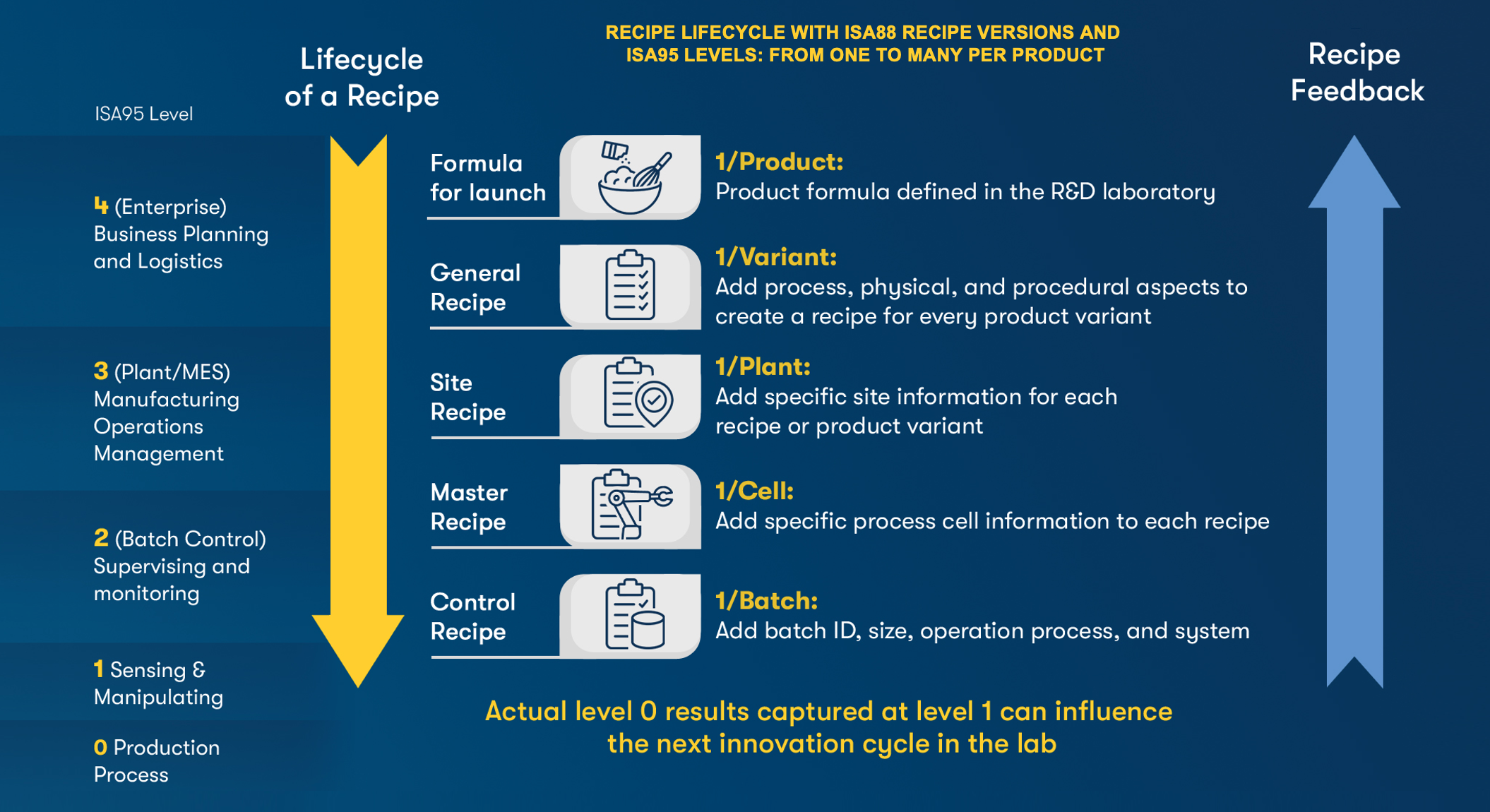
Multi-Disciplinary Workflows
The ERM Concept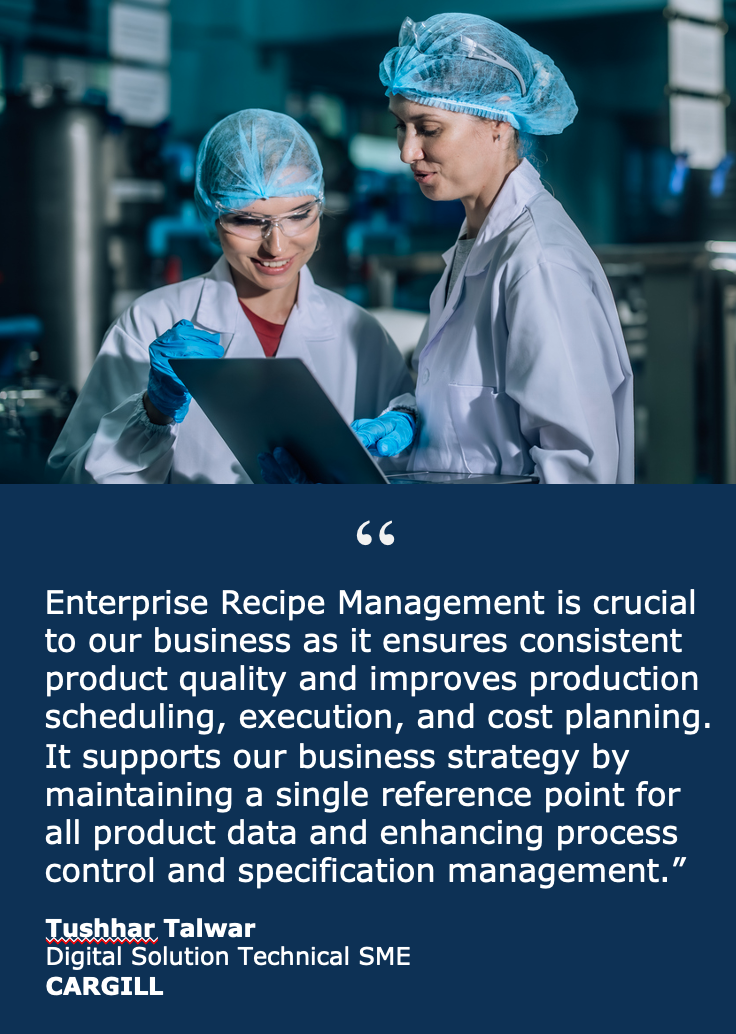 Standardization is at the heart of enterprise success with recipe management. Companies must standardize many interdependent elements for ERM to work. One of the drivers behind the ISA88 standard, Dennis Brandl, explains that the ERM concept is “Standard product descriptions based on standard definitions of manufacturing operations, based on standard quality attribute definitions, based on standard process parameter and process report definitions.” This illustrates the many layers and facets to standardize for ERM.
ERM in Innovation
The NPDI process begins with innovation. This, in itself, is a multi-disciplinary effort, typically including:
Standardization is at the heart of enterprise success with recipe management. Companies must standardize many interdependent elements for ERM to work. One of the drivers behind the ISA88 standard, Dennis Brandl, explains that the ERM concept is “Standard product descriptions based on standard definitions of manufacturing operations, based on standard quality attribute definitions, based on standard process parameter and process report definitions.” This illustrates the many layers and facets to standardize for ERM.
ERM in Innovation
The NPDI process begins with innovation. This, in itself, is a multi-disciplinary effort, typically including:
- R&D with their associated labs and scientists
- Marketing and consumer research
- Product development
- Packaging design and development
- Process and manufacturing engineering
- Operations or production or manufacturing
- Quality
- Food safety & regulatory
- Materials, procurement & supply chain management
- Manufacturing or production IT
- Automation, controls engineering, and operations technology (OT)
Creating ERM Data Flows
Impact Analysis To succeed, ERM must also include impact analysis. For every change in formulation, materials, equipment, or regulation, the system should review whether to update bills of materials and other recipe details, operations, and work packages. Having all the data does not automatically make this impact analysis effective or efficient. Having it centralized does improve the odds of good impact analysis as well as use for other analytics functions or artificial intelligence (AI). Many Systems ERM typically requires integration between MES and PLM, plus PLM or MES and Batch systems, possibly also integration between MES and ERP or PLM and ERP. For ongoing accuracy and best production results, automation and MES are also connected for complete process data sets without overwhelming the enterprise systems. In the ideal scenario, MES, PLM, ERP, and ERM are integrated through a process digital twin that accurately reflects the product and data flows in virtual form. Solutions for ERM A special set of capabilities is needed for a true ERM solution. Data from multiple systems is one aspect, and data management to handle the recipe data volumes, complexities, and contingencies are all key. Handling recipe transformations, testing, and validation will also typically require special software capabilities. These ERM integrated solutions do exist today, butare not yet in common use. With MES, the as-produced data can readily be fed back to ensure the ERM libraries, models, and rules reflect best practices.
Recipe Management Success
ERM for Success Enterprise Recipe Management eliminates inefficiencies and empowers teams to focus on value-added tasks by streamlining processes, reducing manual work, and enabling better resource allocation. Beyond reducing time to market and improving product quality, ERM allows the company to be more agile and adapt to change faster. One measure of success is how many recipes are directly downloaded and executed at top quality with minimal intervention from local operators. Benefits to Expect Creating an ERM digital thread can deliver significant benefits to multi-site, fast-moving consumer goods companies. Benefits that are a hallmark of ERM success span the lifecycle. They start with accelerated innovation, then faster NPDI or speed to market. ERM should also deliver improved product quality assurance and multi-disciplinary collaboration. Better understanding the impact of changes and decisions can lead to increased efficiency, improved product quality, and lower brand risk. Building an ROI Case Calculating potential value from ERM has many facets. Some factors to consider are reduction of labor, time, utilities, other costs based on a consistent source of data, quick recipe conversion, and less test batch engineering time. MESA White Paper #49 includes a basic spreadsheet approach.6 MES Optimizes ERM Every product’s quality relies on the execution of the recipe at a line or cell in a plant; that’s where MES ensures execution matches the recipe's intent. ERM also uses MES's accurate data on plant capacity, production capabilities, and recipe compliance. Finally, MES data on ‘actuals’ from every batch inform everyone of how that recipe is performing, for brand success. *This summary is an abbreviated version of the ebook and does not contain the full content. For the full report, please visit our sponsor Siemens. If you have difficulty obtaining a copy of the research, please contact us. [post_title] => How MES Supports Enterprise Recipe Management [post_excerpt] => [post_status] => publish [comment_status] => open [ping_status] => open [post_password] => [post_name] => enterprise-recipe-management [to_ping] => [pinged] => [post_modified] => 2025-04-17 09:33:42 [post_modified_gmt] => 2025-04-17 13:33:42 [post_content_filtered] => [post_parent] => 0 [guid] => https://tech-clarity.com/?p=21810 [menu_order] => 0 [post_type] => post [post_mime_type] => [comment_count] => 0 [filter] => raw ) [15] => WP_Post Object ( [ID] => 21842 [post_author] => 2 [post_date] => 2025-04-16 10:00:48 [post_date_gmt] => 2025-04-16 14:00:48 [post_content] =>Siemens Support for Service Exceeded Our Expectations
It’s our goal as analysts to stay informed about the software solutions available on the market and how they drive business value for manufacturers. We do this by conducting surveys, speaking with manufacturers, attending events, and taking briefings from solution providers. One of the things that excites us the most is when we learn something new. Recently, we learned that we were underestimating Siemens Digital Industries Software Service Lifecycle Management (SLM) capabilities. We thought it was worth sharing.
Deep Support for Product and Service Data
One of the primary ways that Product Lifecycle Management (PLM) solutions can help add value in a device or equipment's service phase is by providing technical data downstream. Engineering data is highly valuable to service planners, techs, and other support personnel. We were aware of the capabilities Siemens delivers in this area based on prior conversations and briefings. Siemens understands how products are designed, made, and serviced.
Siemens Teamcenter is a proven PLM solution and Teamcenter SLM has matured nicely over the years. Siemens followed a natural expansion beyond engineering and manufacturing BOMs to support the service BOM. We’ve seen how Teamcenter manages multidisciplinary data across product lifecycles and know it can manage complex configurations for both standard and engineer-to-order (ETO) products. Teamcenter’s ability to manage variants, revisions, and changes for serialized assets creates valuable product intelligence for service-related processes.

Teamcenter’s capabilities in both PLM and SLM also create an opportunity for customers to close the loop from service back to engineering. An integrated view of service and product data allows engineers better visibility downstream so they can better design for service and quality based on real-world feedback.
Supporting the Service Lifecycle
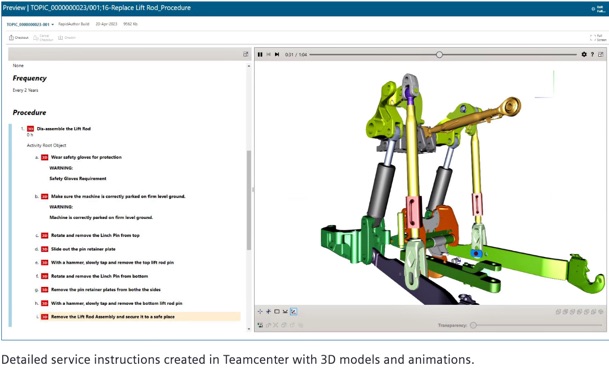 We knew that Teamcenter SLM was a strong source of product- and service-related data and recognized that this underlying information is crucial to effective service. Our research shows the value of extending PLM data into the “in use” phase of the lifecycle. Integrating design and service information provides even greater business value, as shown in our recent infographic on integrated service. The combination of product and service intelligence to support service transformation is compelling. As our Extending Digital Thread to the Customer Experience research shares the value of integrating the digital thread across the development and service lifecycles allows companies to develop a more intimate understanding of the customer and product experience and create new value from increasing profitability with lower costs and higher revenue from spares, suppliers, upgrades, replacements, and cross-selling opportunities.
We knew that Teamcenter SLM was a strong source of product- and service-related data and recognized that this underlying information is crucial to effective service. Our research shows the value of extending PLM data into the “in use” phase of the lifecycle. Integrating design and service information provides even greater business value, as shown in our recent infographic on integrated service. The combination of product and service intelligence to support service transformation is compelling. As our Extending Digital Thread to the Customer Experience research shares the value of integrating the digital thread across the development and service lifecycles allows companies to develop a more intimate understanding of the customer and product experience and create new value from increasing profitability with lower costs and higher revenue from spares, suppliers, upgrades, replacements, and cross-selling opportunities.
Teamcenter SLM goes further than providing existing data by expanding beyond engineering data to information like service procedures. Not only can the solution manage and share this information, their Tech Pubs/RapidAuthor solution leverages design models and data to develop accurate, 3D technical documentation including visual and animated service instructions.
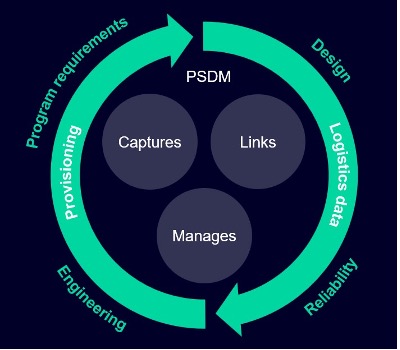 Product Support Data Management (PSDM)
Product Support Data Management (PSDM)
One specific way Siemens drives value is with its Product Support Data Management (#PSDM) solution. PSDM is a standards-based approach to documenting product support requirements tied to specific asset configurations. The solution brings together product lifecycle and logistics support data, leveraging the standard GEIA-STD-0007. The standard originated from the military to support government contracts but is applicable across a variety of industries. Siemens adopted this standard and incorporated it in the Teamcenter data model to support maintenance and logistics related data imports and exports.
Siemens Partners to Support Sales and Service Execution
Beyond sharing information, our research points out the value of strong sales and service execution support. Manufacturing and service companies must improve and optimize the processes supporting sales and service operations to grow their aftermarket business. Sales and service transformation requires convergence across people, processes, data, and systems in the engineering and enterprise systems. Customer interactions, spare parts, service contracts, warranty entitlements, and other service complexities are managed in solutions like CRM, Field Service Management, Enterprise Asset Management (EAM), and even ERP. Siemens’ customers can integrate with these systems, but that doesn’t create a seamless process.
 This is where our understanding of Siemens’ capabilities needed to expand. Siemens has been working to bridge the gap between design, service planning, and service execution. They now support the front office, sales teams, customer service, and even equipment operators through strong partnerships. This brings the value of SLM to the front office while keeping it tied into Teamcenter PLM to extend the value of rich digital data beyond the engineering population, in the right context, to enable execution processes. Siemens is not trying to recreate what field service and CRM solutions do, but instead make them more valuable by providing a more complete solution to their customers by connecting with them.
This is where our understanding of Siemens’ capabilities needed to expand. Siemens has been working to bridge the gap between design, service planning, and service execution. They now support the front office, sales teams, customer service, and even equipment operators through strong partnerships. This brings the value of SLM to the front office while keeping it tied into Teamcenter PLM to extend the value of rich digital data beyond the engineering population, in the right context, to enable execution processes. Siemens is not trying to recreate what field service and CRM solutions do, but instead make them more valuable by providing a more complete solution to their customers by connecting with them.
Siemens now supports cohesive processes and a consistent digital thread from engineering through field services and sales. Siemens was able to leverage their open approach and rich APIs in their platform to support a variety of partnerships. These partnerships include IBM Maximo Application Suite for EAM and Salesforce for CRM. In both of these cases, Siemens focuses on the product data and service knowledge, not the customer data and service execution. This is exciting news, and we were happy to hear that Teamcenter SLM for Salesforce has been available on the Salesforce AppExchange for about a year. The Salesforce partnership also opens up Teamcenter’s product and service data to Agentforce, Salesforce’s AI offering, unlocking significant new opportunities to leverage the cohesive digital thread.
Example
Siemens demonstrated an example of how combining an integrated PLM-CRM environment with AI can streamline and improve customer experience, service performance, and profitability. They showed how Agentforce could be deployed on an equipment manufacturer’s website. A customer can visit the site and enter an asset name and serial number, which would be interpreted to create a draft case for review, combining details about the configuration, including product information like 3D visuals, service data like detailed service instructions, and business data such as warranty terms in one place. They went further to show how the combined, AI-enabled solution could identify additional opportunities like a service upgrade based on the combined data. It was a compelling view of an end-to-end integrated process.
Our Take
Siemens has a lot to offer across the product and service lifecycle through the Siemens Xcelerator portfolio and their partnerships. Siemens’ value in SLM goes beyond product data and service knowledge to service execution, enabling an integrated digital thread. The offering extends on Siemens’ deep expertise and strength in PLM and their open platform approach. Together with their partners, they have developed a very compelling offering spanning the product and service lifecycle. If you haven’t seen it in a while, it’s worth a deeper look. We learned quite a bit.
Thank You
Thank you for the briefing Kerri Doyle, Brian Johnsen, Dominique Gilles, Yishai Barak, and Rajvi Vaidya for taking the time for the briefings, we appreciate your time.
[post_title] => Siemens Support for SLM Exceeded Our Expectations [post_excerpt] => [post_status] => publish [comment_status] => open [ping_status] => open [post_password] => [post_name] => siemens-slm [to_ping] => [pinged] => [post_modified] => 2025-05-19 13:47:33 [post_modified_gmt] => 2025-05-19 17:47:33 [post_content_filtered] => [post_parent] => 0 [guid] => https://tech-clarity.com/?p=21842 [menu_order] => 0 [post_type] => post [post_mime_type] => [comment_count] => 0 [filter] => raw ) [16] => WP_Post Object ( [ID] => 21799 [post_author] => 2572 [post_date] => 2025-04-10 10:00:37 [post_date_gmt] => 2025-04-10 14:00:37 [post_content] =>We recently had a chance to catch up with Siemens Digital Industries Software and get an update on NX. We heard about recent developments, the latest strategic direction for #CAD, their efforts to support comprehensive workflows, and progress to enable a Model-Based Enterprise (MBE). Here are a few of the highlights.
NX Innovation and Customer Adoption
The NX team at Siemens has been very busy. They are on a continuous release cycle, with major releases every December and June. The 4200 enhancements and 45 patents reflect the level of innovation investment over the last year. At the same time, they maintain high levels of quality, as 75% of NX customers are on a release from 2024 or 2023. They've also added over 1000 new customer logos, especially in the SMB space. Their cloud offering, NX X, largely drove this. Additionally, they continue to receive awards from peer review sites like G2 and Trust Radius.
Introducing Designcenter
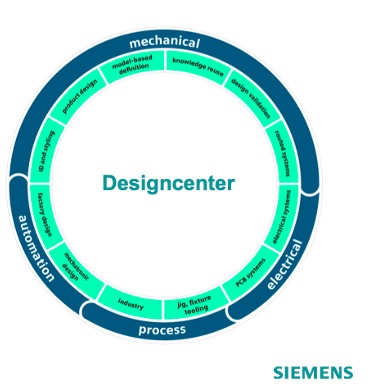 On January 6, 2025, at the CES trade show in Las Vegas, Siemens introduced Designcenter.
On January 6, 2025, at the CES trade show in Las Vegas, Siemens introduced Designcenter.
Designcenter is a new brand that combines both CAD products, NX and Solid Edge, to provide a single scalable mechanical CAD offering. The intent is to offer comprehensive workflows that integrate with Teamcenter and Simcenter to provide a seamless experience across design, simulation, and manufacturing.
Both NX and Solid Edge are built on the same Parasolid kernel, making it easier to work with Solid Edge models in NX and vice versa. Over the last couple of years, Siemens has invested in evolving the user interfaces to give them a similar look and feel. This is intended to make it easier for users to switch between the products. Designcenter furthers this approach to bring the two brands closer.
Scalable and Comprehensive
To meet customer needs, whether they are a large, medium, or small enterprise, Designcenter offers four options:
- Essentials
- Standard
- Advanced
- Premium
Essentials is the rebranded product that was formerly Zel X. Standard, Advanced, and Premium are tiered offerings so that customers can match the package with their needs, yet have options to scale should their requirements evolve. All three include built-in data management.
Within these packages, NX offers extensive capabilities for typical parts, assemblies, and drawings. However, based on the business, organizational function, industry, project stage, and supply chain role, some users may need more specialized functionality that is available in an optional module. In the past, it was difficult to justify the investment in an optional module, especially if it was for functionality that wasn't needed regularly. Siemens has addressed this challenge with a value-based licensing model for NX. This concept has worked well in the Simulation/CAE space to give users access to specialized analyses when needed, so it makes sense to apply it to CAD as well.
NX's value-based licensing model uses tokens for optional modules, which allows customers to use and return tokens for different functionalities. The intent is to give customers a cost-effective, flexible way to access specialized functionality when needed. For example, an aerospace company may want to use the token pool to take advantage of optional modules to design machined aerospace components or composite parts.
Enabling a Model-Based Enterprise (MBE)
Tech-Clarity’s research has found that while companies who have started the journey to adopt MBE report many benefits, including better traceability, greater agility, and faster time to market, there are still many barriers to adoption. Interestingly, people and culture challenges are even bigger obstacles than either technology or process challenges. To overcome this, the Product and Manufacturing Information (PMI) embedded in the CAD model needs to become more consumable to downstream departments. Siemens is looking to do this with NX Stage Models, which help manufacturing engineers decompose design models into manufacturing stages, and a new NX Inspector, which supports a new standard for model-based characteristics.
In 2024, the DMSC™, an ANSI Accredited Standards Developing Organization and an ISO A-Liaison, released the Model-Based Characteristics Standard (MBC). The new MBC standard defines a common approach for tagging and uniquely identifying product characteristics for quality processes in a way that makes the PMI both human-readable and machine-readable. This is a giant step toward making PMI more usable, which should encourage MBE initiatives. By supporting this new standard, NX Inspector provides a mechanism for automating inspection plans based on the PMI in the CAD model.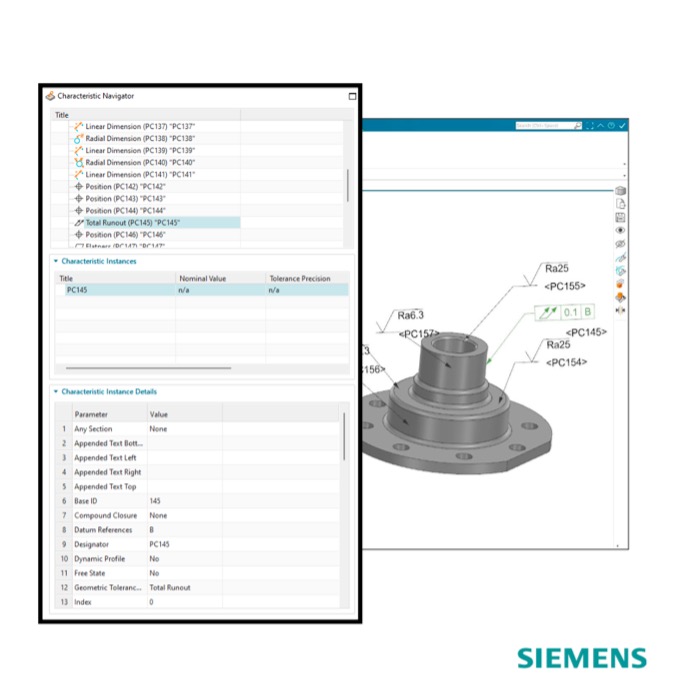
Our Take
It is nice to see all the effort into making NX more accessible, especially to smaller and medium-sized enterprises. Solid Edge customers should also have an easier path to scale up to more advanced capabilities as they need them. The token-based licensing model is also a nice way to make advanced, productivity-improving capabilities available to more users.
What's really exciting to us is the MBE capabilities. The MBE capabilities should be particularly interesting to the Aerospace and Defense industry, which has shown the most interest in MBE.
The vision to move away from 2D drawings has been around for well over 20 years now. However, manufacturing still largely follows a 2D-driven process. Capabilities that leverage semantic PMI to automate downstream processes should go a long way to finally realize that vision. The functionality offered by NX Inspector that supports an opportunity to automate inspection plans based on the 3D model is a big step forward. It should save significant time and reduce the risk of errors introduced with traditional, manual processes that leverage a 2D drawing. This should lead to efficiency gains, which will be a huge motivator for adopting an MBE approach. We look forward to seeing how this evolves, especially as Siemens works towards integrating metrology within its digital industries.
Thank You
Thank you George Rendell, Tod Parrella, Jennifer Piper, and Shaun Ennis for sharing this update.
[post_title] => A Siemens NX Update: Extending Access and MBE [post_excerpt] => [post_status] => publish [comment_status] => open [ping_status] => open [post_password] => [post_name] => siemens-nx [to_ping] => [pinged] => [post_modified] => 2025-07-18 00:20:36 [post_modified_gmt] => 2025-07-18 04:20:36 [post_content_filtered] => [post_parent] => 0 [guid] => https://tech-clarity.com/?p=21799 [menu_order] => 0 [post_type] => post [post_mime_type] => [comment_count] => 0 [filter] => raw ) [17] => WP_Post Object ( [ID] => 21746 [post_author] => 2574 [post_date] => 2025-04-08 09:00:15 [post_date_gmt] => 2025-04-08 13:00:15 [post_content] =>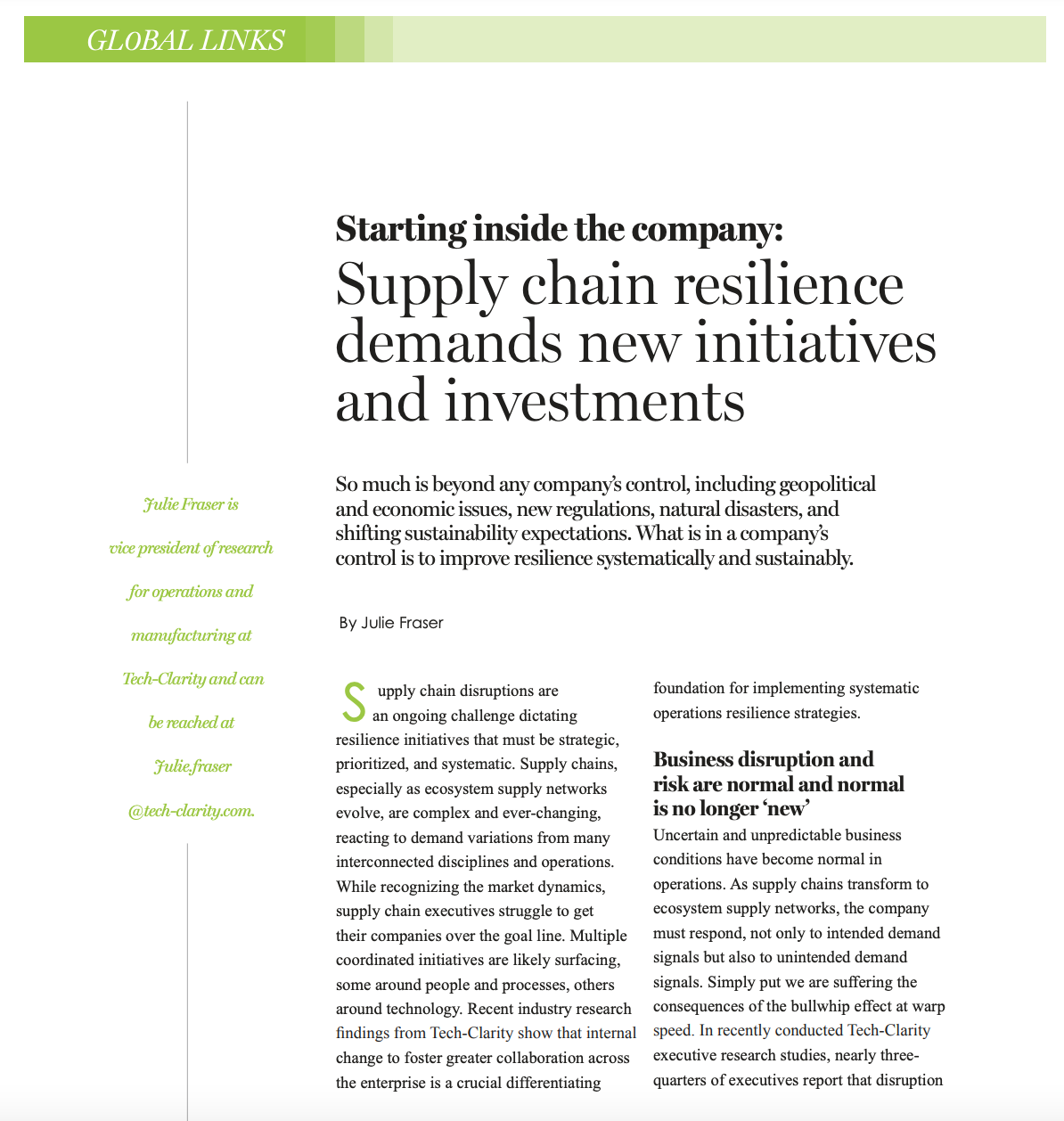 Where’s the best place to start in improving supply chain resilience? Our research shows it’s inside the company. Many companies will need to start new initiatives and make additional investments to ensure their data is flowing for supply chain internal value. Data sharing and collaboration are crucial within supply chain disciplines, but also throughout the company between supply chain and engineering, manufacturing engineering, and the plant floor.
Supply chain and business disruptions are normal and often have severe negative impacts. Some of those factors are outside a company’s control, so most companies are investing in supply chain resilience (70%). Supply chain leaders must invest to tackle the #1 supply chain issue for executives: risk. Most companies need to do more to manage effectively and stay agile in the face of uncertainty, volatility, and ever-changing issues.
So, what to do? Change suppliers? Move production? Pull more production in-house and away from external suppliers? Improve design for supply? All of those might have good results.
Supply Chain resilience inside is the key. Gaining visibility into the product development and manufacturing or “make” areas of the company are crucial differentiators for those companies doing well. How would it be to see changes to products or production capabilities within an hour? Companies that can do that are performing better. Our research suggests that strong data flows across the company are a foundation for supply chain resilience.
Yet for many companies, this will require setting up new initiatives and investing at an enterprise level. Some of the changes might be in employee metrics and incentives to foster collaboration. Another idea is to invest in software that might have agentic AI, improved integration, or multi-tier planning and response capabilities.
Read Julie Fraser’s article in the Global Links section of Supply Chain Management Review that went live in March 2025. The above is a summary, and the full PDF of the article is linked here.
Thanks to Richard Sherman and Supply Chain Management Review for the opportunity to share our views.
[post_title] => Starting Inside the Company: Supply Chain Resilience Requires New Initiatives and Investments
[post_excerpt] =>
[post_status] => publish
[comment_status] => open
[ping_status] => open
[post_password] =>
[post_name] => supply-chain-resilience-inside
[to_ping] =>
[pinged] =>
[post_modified] => 2025-04-08 09:05:44
[post_modified_gmt] => 2025-04-08 13:05:44
[post_content_filtered] =>
[post_parent] => 0
[guid] => https://tech-clarity.com/?p=21746
[menu_order] => 0
[post_type] => post
[post_mime_type] =>
[comment_count] => 0
[filter] => raw
)
[18] => WP_Post Object
(
[ID] => 21722
[post_author] => 2574
[post_date] => 2025-04-02 10:00:30
[post_date_gmt] => 2025-04-02 14:00:30
[post_content] =>
Where’s the best place to start in improving supply chain resilience? Our research shows it’s inside the company. Many companies will need to start new initiatives and make additional investments to ensure their data is flowing for supply chain internal value. Data sharing and collaboration are crucial within supply chain disciplines, but also throughout the company between supply chain and engineering, manufacturing engineering, and the plant floor.
Supply chain and business disruptions are normal and often have severe negative impacts. Some of those factors are outside a company’s control, so most companies are investing in supply chain resilience (70%). Supply chain leaders must invest to tackle the #1 supply chain issue for executives: risk. Most companies need to do more to manage effectively and stay agile in the face of uncertainty, volatility, and ever-changing issues.
So, what to do? Change suppliers? Move production? Pull more production in-house and away from external suppliers? Improve design for supply? All of those might have good results.
Supply Chain resilience inside is the key. Gaining visibility into the product development and manufacturing or “make” areas of the company are crucial differentiators for those companies doing well. How would it be to see changes to products or production capabilities within an hour? Companies that can do that are performing better. Our research suggests that strong data flows across the company are a foundation for supply chain resilience.
Yet for many companies, this will require setting up new initiatives and investing at an enterprise level. Some of the changes might be in employee metrics and incentives to foster collaboration. Another idea is to invest in software that might have agentic AI, improved integration, or multi-tier planning and response capabilities.
Read Julie Fraser’s article in the Global Links section of Supply Chain Management Review that went live in March 2025. The above is a summary, and the full PDF of the article is linked here.
Thanks to Richard Sherman and Supply Chain Management Review for the opportunity to share our views.
[post_title] => Starting Inside the Company: Supply Chain Resilience Requires New Initiatives and Investments
[post_excerpt] =>
[post_status] => publish
[comment_status] => open
[ping_status] => open
[post_password] =>
[post_name] => supply-chain-resilience-inside
[to_ping] =>
[pinged] =>
[post_modified] => 2025-04-08 09:05:44
[post_modified_gmt] => 2025-04-08 13:05:44
[post_content_filtered] =>
[post_parent] => 0
[guid] => https://tech-clarity.com/?p=21746
[menu_order] => 0
[post_type] => post
[post_mime_type] =>
[comment_count] => 0
[filter] => raw
)
[18] => WP_Post Object
(
[ID] => 21722
[post_author] => 2574
[post_date] => 2025-04-02 10:00:30
[post_date_gmt] => 2025-04-02 14:00:30
[post_content] =>  How can companies be sure to gain value from manufacturing analytics and AI projects? It turns out benefits are ubiquitous for those who have invested. Yet the Top Performers in our new survey of over 400 manufacturing respondents indicates some key differences that improve their results.
Please enjoy the summary* below. For the full research, please visit our sponsor MESA International (registration required).
How can companies be sure to gain value from manufacturing analytics and AI projects? It turns out benefits are ubiquitous for those who have invested. Yet the Top Performers in our new survey of over 400 manufacturing respondents indicates some key differences that improve their results.
Please enjoy the summary* below. For the full research, please visit our sponsor MESA International (registration required).
Table of Contents
- It's Time to Invest in Analytics and AI
- Why Invest in Manufacturing Operations and Analytics
- Business Challenges
- Smart Manufacturing Journey
- Smart Manufacturing Progress
- Investment Outcomes
- Analytics May Pay Off Faster Than Other Software
- Analytics and AI Deliver Benefits that Matter
- Top Performers Are Role Models
- Smarter Manufacturing
- Descriptive Analytics
- Predictive Analytics
- Predictive Analytics Hurdles
- Overcoming the Challenges
- Predictive Analytics Benefits
- Generative AI and Analytics to Support and Guide
- GenAI Hurdles
- GenAI Benefits
- Rapid Benefits from GenAI
- Manufacturing DataOps Needs Improvement
- Industry-Specific AI
- Key Takeaways
- Recommendations
- About the Research
- Acknowledgments
It’s Time to Invest in Analytics and AI
Analytics and AI Deliver Value to Manufacturing Analytics and artificial intelligence (AI) are hot topics in manufacturing operations today. This research explores what companies are doing, why, and how. The data from 423 responses from companies that manufacture or produce worldwide is conclusive. Those investing in Analytics and AI are gaining substantial benefits. The benefits matter, as they are in the areas that match their objectives: cost, efficiency/productivity, quality, and error-proofing most commonly. 100% of these respondents are facing significant challenges, and 99% are investing in manufacturing operations, analytics, and AI to address them. Those using analytics and AI longer tend to see benefits in more areas. Top Performers doing better on operations metrics are also outperforming Others on business metrics. What are they doing differently? More of them are using dashboards, analytics, and AI. They also prioritize use cases based on business value.Analytics May Pay Off Faster Than Other Software
Quick Positive Impact Investments are always made to yield a return or positive impact. Just as the previous time MESA partnered to conduct this research2, advanced analytics was the top application for rapidly delivering ROI. Nearly a third of the respondents gained the value of analytics and AI relatively rapidly. Changes Over Time We suspect many of the changes between 2022 and 2025 are due to the different sets of respondents. Other possible reasons for the significant changes: The big new drive to AI in the past couple of years is likely a factor in its more prominent showing. Maintenance and asset management have been a focus of predictive analytics. In contrast, sustainability has moved into the realm of legal and regulatory requirements, which may be slowing the benefits. Critical Data Each use case will require a specific set of data. New technologies make it easier to identify and extract essential data from existing sources. Data Foundation Most of these projects require modeling and data-cleansing efforts to deliver benefits. Companies gaining rapid benefits from analytics and AI will likely already have a good data foundation. Paving the Path to Value Companies may get a solid data foundation by implementing some of the other systems on this list, such as ERP, Asset Management, and Manufacturing Execution Systems (MES) or Manufacturing Operations Management (MOM).
Analytics and AI Deliver Benefits That Matter
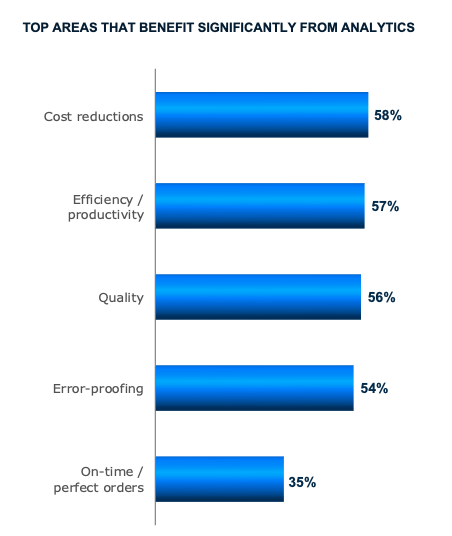 100% Gaining Benefits
Analytics projects are delivering significant benefits that support top drivers and help meet challenges. Every one of these respondents (100%) reports gaining benefits from analytics programs, which is excellent news for our industries.
Cost
Cost reduction is the #1 driver (p. 4) and actual benefit. Most companies know they could lower costs, but analytics and AI can help to pinpoint where to focus efforts. Predictive and preventive analytics can avoid an array of unnecessary expenses due to waste.
Efficiency & Quality
Efficiency contributes to cost and indicates people are effective, even in the face of a skilled workforce shortage. Error-proofing is necessary for less skilled staff, and even more experienced staff can benefit from error-proofing when change is rapid, the product mix through the plant is high, or specifications change frequently.
What Customers Need
On-time perfect orders make the company a reliable supplier, leading to revenue opportunities and being viewed as trustworthy in these uncertain times. Customers also seek quality; internally that lowers costs, increases revenue opportunity, improves supply chain resilience, and enhances sustainability.
And More
Other areas where respondents report significant benefits from analytics programs include:
100% Gaining Benefits
Analytics projects are delivering significant benefits that support top drivers and help meet challenges. Every one of these respondents (100%) reports gaining benefits from analytics programs, which is excellent news for our industries.
Cost
Cost reduction is the #1 driver (p. 4) and actual benefit. Most companies know they could lower costs, but analytics and AI can help to pinpoint where to focus efforts. Predictive and preventive analytics can avoid an array of unnecessary expenses due to waste.
Efficiency & Quality
Efficiency contributes to cost and indicates people are effective, even in the face of a skilled workforce shortage. Error-proofing is necessary for less skilled staff, and even more experienced staff can benefit from error-proofing when change is rapid, the product mix through the plant is high, or specifications change frequently.
What Customers Need
On-time perfect orders make the company a reliable supplier, leading to revenue opportunities and being viewed as trustworthy in these uncertain times. Customers also seek quality; internally that lowers costs, increases revenue opportunity, improves supply chain resilience, and enhances sustainability.
And More
Other areas where respondents report significant benefits from analytics programs include:
- Office visibility into performance (22%), which is crucial to executives and other disciplines since manufacturing is at the center of the company.
- Planning and scheduling at 21% is heavily dependent on insights and is inherently an analytical process.
- Customer satisfaction and collaboration (20%) based on analyzed data and sharing insights can drive revenue.
- Some get benefits in waste/scrap/energy, asset performance and uptime, comparability among lines or sites, employee satisfaction, supplier issues, and returns or warranty costs.
Key Takeaways
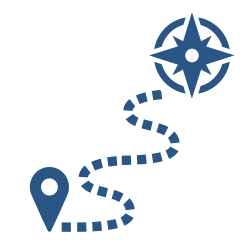 Progress: Manufacturers are moving along the Smart Manufacturing path. Many have multiple projects underway or are already seeing results.
Progress: Manufacturers are moving along the Smart Manufacturing path. Many have multiple projects underway or are already seeing results.- Seeking Data Outcomes: Manufacturers are seeking some fundamental data management outcomes from their investments, such as easy access to high-quality, timely, complete plant data for plant employees and integration of equipment, plant, and enterprise data.
- Interested in New Technologies: Many are also focused on advanced analytics and IIoT.
- Varied Drivers: What matters most to manufacturers right now varies, but cost reduction, supply chain resilience, sustainability, workforce skills, and revenue opportunity top the list.
- AI Delivering Benefits: Fortunately, AI in all its forms is delivering benefits in desired areas. Benefits come relatively quickly, with expected payback often in less than a year.
- Supporting Operations: AI can help fill the knowledge gap in today’s workforce, driving efficiency and guiding people.
- Key Differences: Top Performers are more likely to have organizational structures, capabilities, and technologies to support their success.
- Room for Improvement: Nearly all manufacturers we surveyed could improve their data management, governance, accessibility, and operations. We are growing as an industry in this area.
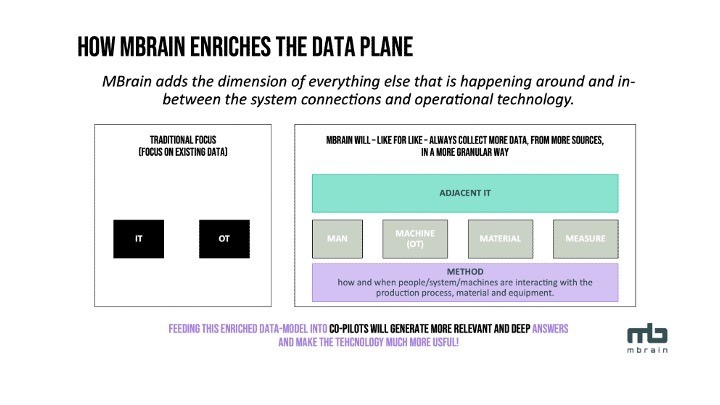
What does it take to digitalize assembly, an area where people must participate? Quite a lot, especially with complex configured products. Over time, MTEK Industry AB has consistently focused on developing software to support complex discrete assembly operations. They keep adding functionality in MOM and beyond to the MBrain digital production system. Integrating to equipment, informing people, and improving are core. They recently added a no-code IT integration platform, Mint, for enterprise data flow. They are delivering value in weeks.
Assembly Focus
For several years, MTEK has focused on creating no-code software that supports manufacturers with complex discrete manufacturing operations typically characterized by configured products, takted or untakted assembly flows, and a high reliance on manual operations. This market has largely been underserved, partly because it’s very complex and changes frequently, often for every configured product (“batch-size one”). Most of these companies have some equipment and automation, but many operations also rely on people since variation is generally the enemy of automation. MTEK started in 2002 as a manufacturing excellence consulting company, so its roots are deep in these industries.
Broad Functionality
Not constrained by what is traditionally included in MES, they have built many functions. MTEK calls it a Digital Production System. MBrain has core functions focused on delivering visibility, a large variety of “make” functions, and a suite of “improve” functions to make lean best practices digital. These functions support specific assembly challenges such as planning, andon, configuration QA, line tolerance, and user competences.
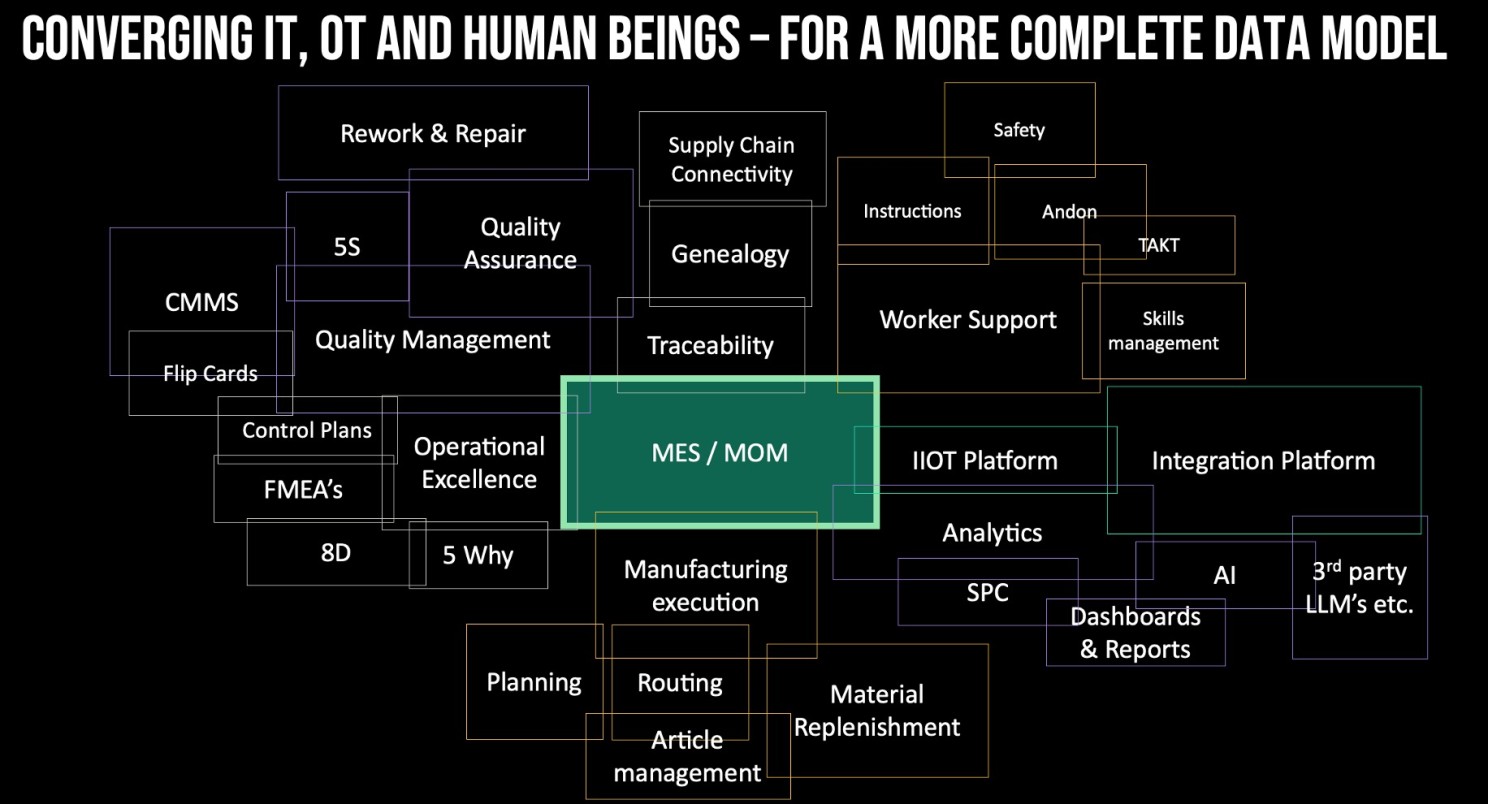
Traditionally, this scope might require four or five specialized systems besides MES. Because it’s no-code, once a customer gets proficient, they can – and typically do – expand it further to meet their specific needs.
Start Where You Are
Anyone who has worked in an assembly operation, particularly a takted one, knows how critical the processes are to keeping products flowing through the plant. MBrain includes a Process, or Method Builder, which is the core tool for constructing a digital replica of the logic of your production and the heart of why MBrain sets out to be a Digital Production System.
They encourage customers to start by mapping their current methods and keep working as they have. Given the no-code design, manufacturers can use the system to identify areas for improvement and then implement them. With more rigid system architectures, clients typically need to identify the “to-be” state before implementation. MTEK challenges that logic and way of working with a more flexible tool.
They can use or later add elements such as getting product data from PLM, reporting materials consumption to ERP, pushing a recipe to a machine, or printing a label. The great news is that customers can view the method or workflow in production, maintenance, quality, etc., at any level of granularity. This supports both skilled and less skilled workers at just the level they need.
Mid-Size Operations Typically
While manufacturers are all different, the MTEK team realized these complex assembly operations have a typical profile. Whether the plant is part of a larger group or the company's entire operations, the facilities are typically 100-250 people, with around $100M in output (+/- 50%). They are often in smaller towns, which limits how large operations can be. Typically, even larger companies are also built by acquiring many smaller operations – meaning there are geographical and historical reasons for the size of a typical plant in discrete manufacturing and assembly. Focusing on this scope of operation, they knew a traditional multi-million dollar, multi-year MES implementation was not the best approach. MTEK’s no-code approach enables MBrain to be both affordable and configurable to the specific operating needs of each customer.
Microsoft Azure IoT Operations Partner
In November 2024, Microsoft’s Azure IoT Operations included MTEK as a launch partner. This is a prestigious position in the Microsoft Adaptive Cloud approach for cloud-to-edge connectivity in manufacturing. Using the Mint and MTalk elements of MTEK’s digital production system, data from equipment, sensors, IoT devices, and adjacent IT systems can feed not only MBrain but also cloud-based analytics. MTEK is strong on its own, but the Microsoft partnership illustrates the advanced nature of their software architecture to enable scaling.

No-Code Mint for IT Integration
The new addition to the MTEK product family is a no-code integration platform, Mint. This innovation from MTEK was originally designed to remove the barrier to growth created by the monetary cost and delay caused by traditional integration work.
As the platform has been deployed with clients, however, MTEK has noticed that the bulk of the value comes from creating a much more integrated systems architecture and event-driven IT/OT stack. Gaining data flows among IT systems can be a powerful and transformative step for manufacturers. The goal is not just to integrate IT systems but to integrate and automate business processes seamlessly. This patent-pending approach to integration can serve MBrain customers and others.
Customer Success
Much of the breadth of functionality has come from customer needs. Since 2020, MTEK has had success with complex discrete assembly customers, including many larger companies whose names you recognize. In one larger company, Accenture was the service partner and saw the value of MBrain. With this no-code approach, many customers report seeing results in a couple of weeks after starting to deploy MBrain. This is not possible with traditional full-code manufacturing software. With the improved IT integration of Mint, the value of these deployments could continue to grow even beyond the MBrain functional footprint.
Solid Combination
No-code, but with built-out functionality out of the box as a starting point, is a strong starting point. Adding so much functionality beyond traditional MES allows MTEK to lay claim to a larger footprint and deliver more value. Integrating the lean tools natively gives continuous improvement a leg up. Integration to automation with MTalk supports automated aspects of the operation. Adding the Mint integration platform addresses one of the most troubling issues in manufacturing digital transformation, helping data flow among systems across the company.
Assembling for the Future
We are convinced that assembly-based manufacturers should explore the MTEK Digital Production System. It seems to have both industry-specific functions that are ready to use and extreme configurability with the no-code approach. Thank you, Tord Johnson and Oscar Wallner, for updating me.
[post_title] => MTEK’s Digital Production System Delivers Value for Complex Assembly in Weeks [post_excerpt] => [post_status] => publish [comment_status] => open [ping_status] => open [post_password] => [post_name] => digital-production-system [to_ping] => [pinged] => [post_modified] => 2025-07-23 09:38:33 [post_modified_gmt] => 2025-07-23 13:38:33 [post_content_filtered] => [post_parent] => 0 [guid] => https://tech-clarity.com/?p=21790 [menu_order] => 0 [post_type] => post [post_mime_type] => [comment_count] => 0 [filter] => raw ) ) [post_count] => 20 [current_post] => -1 [before_loop] => 1 [in_the_loop] => [post] => WP_Post Object ( [ID] => 22080 [post_author] => 2574 [post_date] => 2025-05-30 10:08:26 [post_date_gmt] => 2025-05-30 14:08:26 [post_content] =>ComplianceQuest made some significant announcements at its recent ConQuest customer conference. The first was to identify the space where they play, as a platform and integrated software suite to clean up the messy “middle office.” They also continued to add more agentic AI to the platform to support the people using the applications sitting on it. The other key news came before the event: the release of SupplierQuest, which reaches beyond supplier quality to supplier management, onboarding, collaboration, and performance management.
Cleaning Up the Middle Office
ComplianceQuest has named its vision the Connected Middle Office Platform. Think about how ERP long ago integrated back-office data and workflows, such as HR, Finance, and Supply Chain, for greater efficiency. Since then, CRM has helped optimize the front office activities, including sales, marketing, and service. What’s in the middle? ComplianceQuest says core operations, and they are fragmented, manual, and lack a way to collaborate among functions.
With a proven platform and multi-module solutions for QMS, EHS, Supplier Management, and PLM, ComplianceQuest has a strong story for this middle office. Our research supports the ComplianceQuest view. In our Making Manufacturing Analytics and AI Matter survey, manufacturers’ top investment aim is gaining easy access to high-quality, timely, and complete plant data. Today, many struggle to share operations data, put it in context, and use it to make sound decisions. The ComplianceQuest platform, with its single database, enables collaboration and closed-loop processes across these disciplines and data sets. Consider how a DFMEA can be connected to complaints, CAPAs, and regulatory reports.

AI Agents
AI agents to assist humans in this middle office work are trained only on each customer’s data. ComplianceQuest has incorporated its years of experience in developing these agents. CQ AI agents focus on activities such as generating content, finding and connecting relevant data across the system, forecasting future outcomes, leveraging chat to intake information and create records , and communicating with suppliers through intelligent emails that turn into actionable records . This reduces redundant and duplicated data, enhances worker productivity, and augments data-driven decisions.
ComplianceQuest has been releasing AI since 2022, primarily as categorization and prioritization and retrieve and relate capabilities. Predictive AI is already embedded and is part of the quality maturity index, supplier performance, and safety incidents functionality. AI is a top priority on the CQ roadmap to improve efficiency and costs and mitigate risk with predictions. All of this is embedded in the platform, not separately licensed, as are the advanced analytics.

Supplier Management
In March, ComplianceQuest introduced its SupplierQuality suite, expanding beyond supplier quality to encompass more aspects of supplier relationship management. Examples include:
- Enabling onboarding with collaboration between quality and procurement
- First article inspection to qualify a supplier, pulling the specs and BOM from PLM.
This expansion leverages the collaborative platform and other solutions and adds capabilities to foster greater success with suppliers during a time of supply chain change.
Looking Forward
ComplianceQuest has always leveraged the Salesforce platform for connectivity. As the company builds out its middle office platform and suite, we will continue to watch for new releases, additions, and improvements. Thank you, Nikki Willett, for catching us up on the latest news from ComplianceQuest.
[post_title] => ComplianceQuest Claims Middle Office and Adds Agents [post_excerpt] => [post_status] => publish [comment_status] => open [ping_status] => open [post_password] => [post_name] => compliancequest-middle-office [to_ping] => [pinged] => [post_modified] => 2025-06-05 10:14:29 [post_modified_gmt] => 2025-06-05 14:14:29 [post_content_filtered] => [post_parent] => 0 [guid] => https://tech-clarity.com/?p=22080 [menu_order] => 0 [post_type] => post [post_mime_type] => [comment_count] => 0 [filter] => raw ) [comment_count] => 0 [current_comment] => -1 [found_posts] => 802 [max_num_pages] => 41 [max_num_comment_pages] => 0 [is_single] => [is_preview] => [is_page] => [is_archive] => [is_date] => [is_year] => [is_month] => [is_day] => [is_time] => [is_author] => [is_category] => [is_tag] => [is_tax] => [is_search] => [is_feed] => [is_comment_feed] => [is_trackback] => [is_home] => 1 [is_privacy_policy] => [is_404] => [is_embed] => [is_paged] => [is_admin] => [is_attachment] => [is_singular] => [is_robots] => [is_favicon] => [is_posts_page] => [is_post_type_archive] => [query_vars_hash:WP_Query:private] => 7cc6ab719c1d5d4e169e620ac3aec9f7 [query_vars_changed:WP_Query:private] => 1 [thumbnails_cached] => [allow_query_attachment_by_filename:protected] => [stopwords:WP_Query:private] => [compat_fields:WP_Query:private] => Array ( [0] => query_vars_hash [1] => query_vars_changed ) [compat_methods:WP_Query:private] => Array ( [0] => init_query_flags [1] => parse_tax_query ) [query_cache_key:WP_Query:private] => wp_query:cf68a544eea721709f37c8cfea777514:0.23594600 17670594990.24518300 1767059499 )All Results for "All"
Five Practices to Ensure Value from AI in Manufacturing
Is AI just a shiny object, or is AI delivering value in manufacturing? Our latest infographic exposes five practices that our research shows Top Performers are using to ensure value for their company. Walk through this infographic to learn a few things you can do to move AI from being a distraction or shiny object to…
Hitachi Digital Services Analyst & Advisor Connect: Three Key Takeaways for Manufacturers
Last week, we had a chance to attend the Hitachi Digital Services Analyst & Advisor event in Dallas. The gathering offered compelling insights into the company’s strategic direction and differentiated capabilities. Through a series of thought-provoking presentations and fireside chats, one theme emerged with clarity and consistency: Hitachi Digital Services’ deep-rooted engineering expertise sets it…
Tech-Clarity adds Digital Innovation and Manufacturing Analyst Rick Franzosa
Tech-Clarity is pleased to announce that we are expanding our research team and extending our Manufacturing Operations and Manufacturing Technology coverage. Well-known industry thought leader, keynote speaker, and research analyst Rick Franzosa is joining Tech-Clarity as Vice President of Research for Manufacturing. Rick brings decades of experience in Manufacturing Operations, specializing in Digital Transformation, Manufacturing…
MedTech: ALM and PLM Better Together
What should MedTech companies consider when integrating ALM and PLM? Software has become a crucial component in MedTech products. However, with software development managed in Application Lifecycle Management (ALM) and hardware managed in Product Lifecycle Management (PLM), the separate systems can create silos within the product development team. With increasing regulatory pressures and trends such…
OpsMate AI Aims to Change Factory Work with Agentic AI
Can agentic AI improve how people work on the factory floor? Can it address the workforce crisis that has resulted in a plateau in productivity and increasing safety incidents? OpsMate AI believes they can do that quickly with their no-code agentic AI platform, which is purpose-built for the complexity and high-stakes environment of manufacturing operations….
Rick Franzosa
Rick Franzosa is the Vice President of Research for Manufacturing for Tech-Clarity. He covers MES/MOM and transitional technologies that support the evolution of manufacturing software technology into the age of Industry 4.0 and AI. Rick has over 40 years of experience in manufacturing software technology, including 10 years as an analyst (Gartner) in addition to…
TwinThread’s Industrial AI Platform and Apps Seeing Quick Results and Rapid Growth
Can you gain operational insights from AI without data scientists or programming? Can you do it at scale in a highly automated environment? TwinThread would say you can. Working to solve this challenge, the company is growing rapidly deploying its SaaS Industrial Digital Twin AI Platform. In November, they were 322 on the Deloitte Fast…
Aras Delivers on Promises, adds Focus on AI
We had the chance to attend the Aras Community Event, ACE 2025, to hear strategy and progress updates from Aras Corporation, their customers, and their partners. It was exciting because it was the 25th Anniversary of ACE and the first time in memory that we’ve seen a keynote speech from a balcony ballroom seat! It…
AI Progress in Improving Industry Productivity
Jim Brown is moderating an AMC Bridge Expert Panel discussion on AI progress in industry. Has AI delivered on the hype? Are manufacturing and AEC companies adopting AI-driven use cases that drive real business value? Have we moved beyond the proof-of-concept phase in AI adoption? The panel will discuss these questions and more to shed…
Enlil Focuses on Accelerating Medical Device Innovation with Compliance
We were recently alerted to a company we weren’t covering because a long-time business friend took a key position there. After a quick review of what they do, Julie Fraser and Jim Brown decided to team up on the briefing because we could already see a combination of QMS and PLM capabilities. We learned that…
Power Panel: Handicapping the Global Digital Transformation Race
How are manufacturers doing at global Digital Transformation? What could accelerate progress? These are a few of the questions that Julie Fraser and other experienced industry analysts will discuss on a panel on June 17th. The session is part of the Manufacturing Leadership Council’s (MLC) Rethink Conference on Marco Island, Florida, and supports its theme,…
Hexagon Delivers a New Digital Industrial Platform to Accelerate Innovation
Jim Brown’s recently published eBook research, The Business Value of An Industrial System of Engagement Platform, introduced the concept of the Industrial System of Engagement (SOE). Following the eBook, he penned a guest post for Hexagon summarizing the eBook and how the Industrial SOE provides a platform to extend the value of current enterprise systems…
Expert Interview: AI Adoption in Consumer Packaged Goods
The Value of AI in Manufacturing is Accelerating There is a lot of talk about the value of artificial intelligence in manufacturing, and rightfully so. Although AI isn’t new, it appears to be reaching a tipping point where companies are more open to exploring its potential and AI techniques are more accessible than ever. Manufacturers…
How MES Supports Enterprise Recipe Management
How can recipe-based producers ensure cost-efficiency and consistent, high-quality products no matter where they are formulated or produced? By implementing enterprise recipe management (ERM) with a manufacturing execution system (MES) to deliver closed-loop data flows in and out of production. Leading Consumer Packaged Goods (CPG), specialty chemical, and other manufacturers are standardizing for ERM. Quite…
Siemens Support for SLM Exceeded Our Expectations
Siemens Support for Service Exceeded Our Expectations It’s our goal as analysts to stay informed about the software solutions available on the market and how they drive business value for manufacturers. We do this by conducting surveys, speaking with manufacturers, attending events, and taking briefings from solution providers. One of the things…
A Siemens NX Update: Extending Access and MBE
We recently had a chance to catch up with Siemens Digital Industries Software and get an update on NX. We heard about recent developments, the latest strategic direction for #CAD, their efforts to support comprehensive workflows, and progress to enable a Model-Based Enterprise (MBE). Here are a few of the highlights. NX Innovation and Customer…
Starting Inside the Company: Supply Chain Resilience Requires New Initiatives and Investments
Where’s the best place to start in improving supply chain resilience? Our research shows it’s inside the company. Many companies will need to start new initiatives and make additional investments to ensure their data is flowing for supply chain internal value. Data sharing and collaboration are crucial within supply chain disciplines, but also throughout the…
Making Manufacturing Analytics and AI Matter
How can companies be sure to gain value from manufacturing analytics and AI projects? It turns out benefits are ubiquitous for those who have invested. Yet the Top Performers in our new survey of over 400 manufacturing respondents indicates some key differences that improve their results. Please enjoy the summary* below. For the full research,…
MTEK’s Digital Production System Delivers Value for Complex Assembly in Weeks
What does it take to digitalize assembly, an area where people must participate? Quite a lot, especially with complex configured products. Over time, MTEK Industry AB has consistently focused on developing software to support complex discrete assembly operations. They keep adding functionality in MOM and beyond to the MBrain digital production system. Integrating to equipment,…
